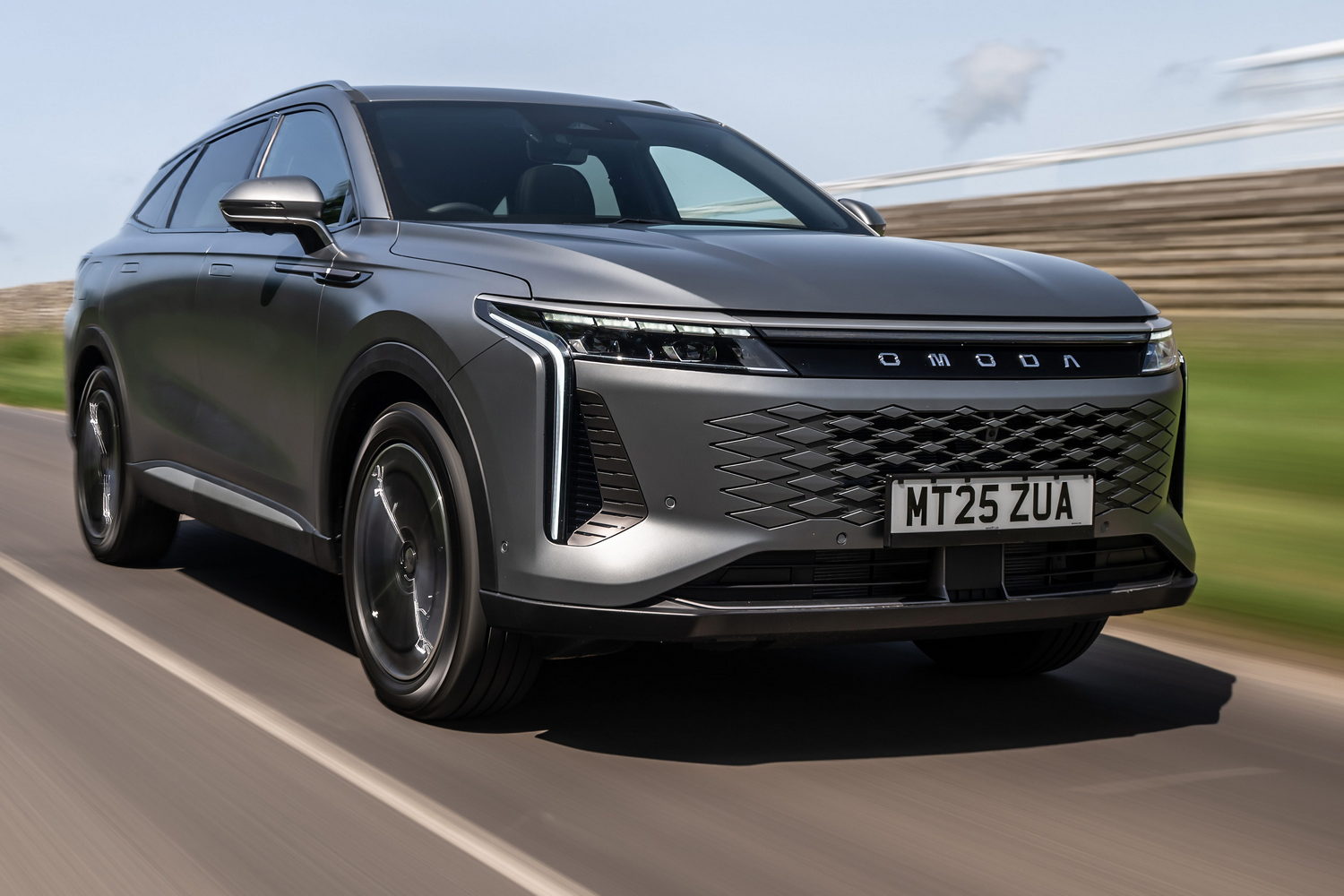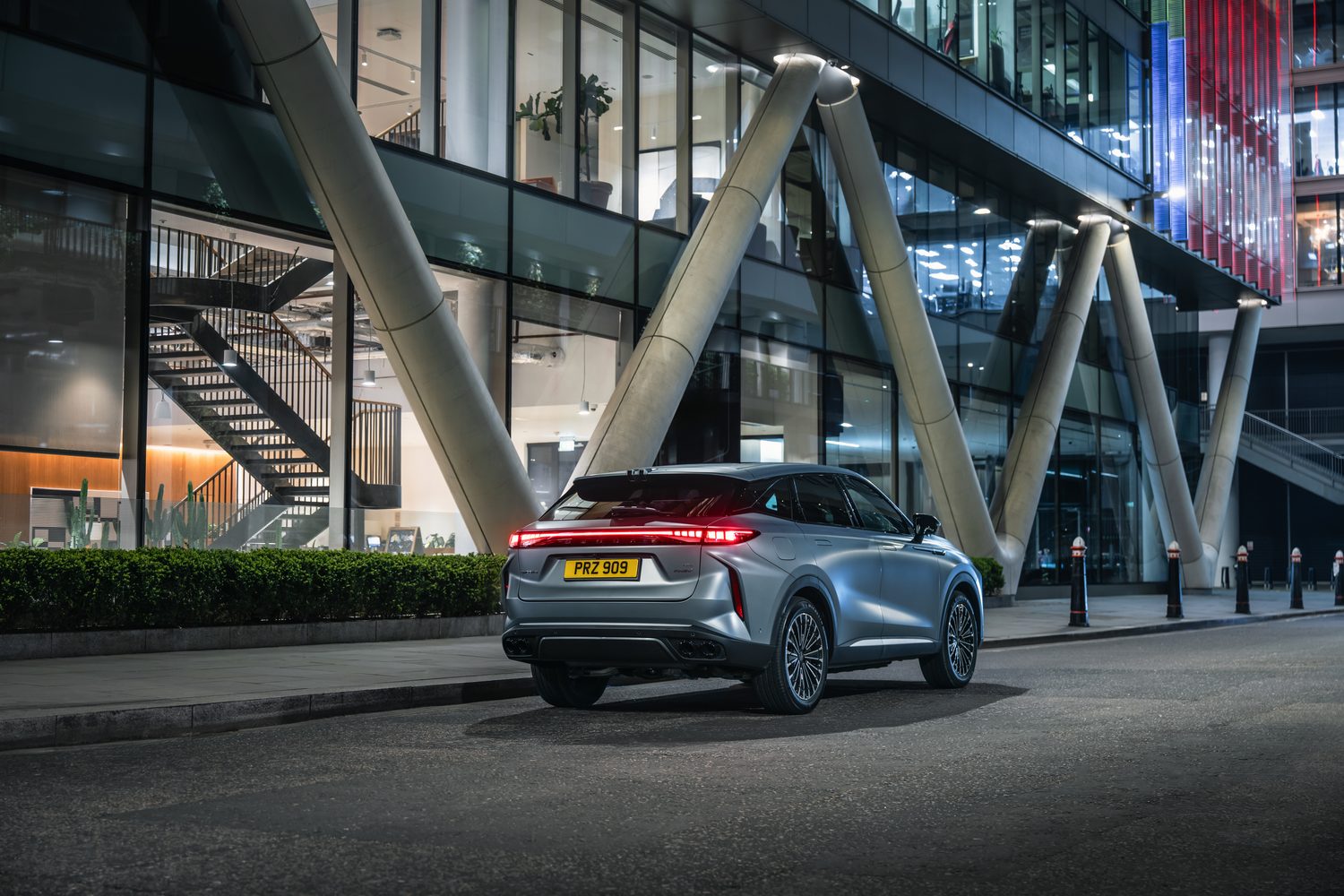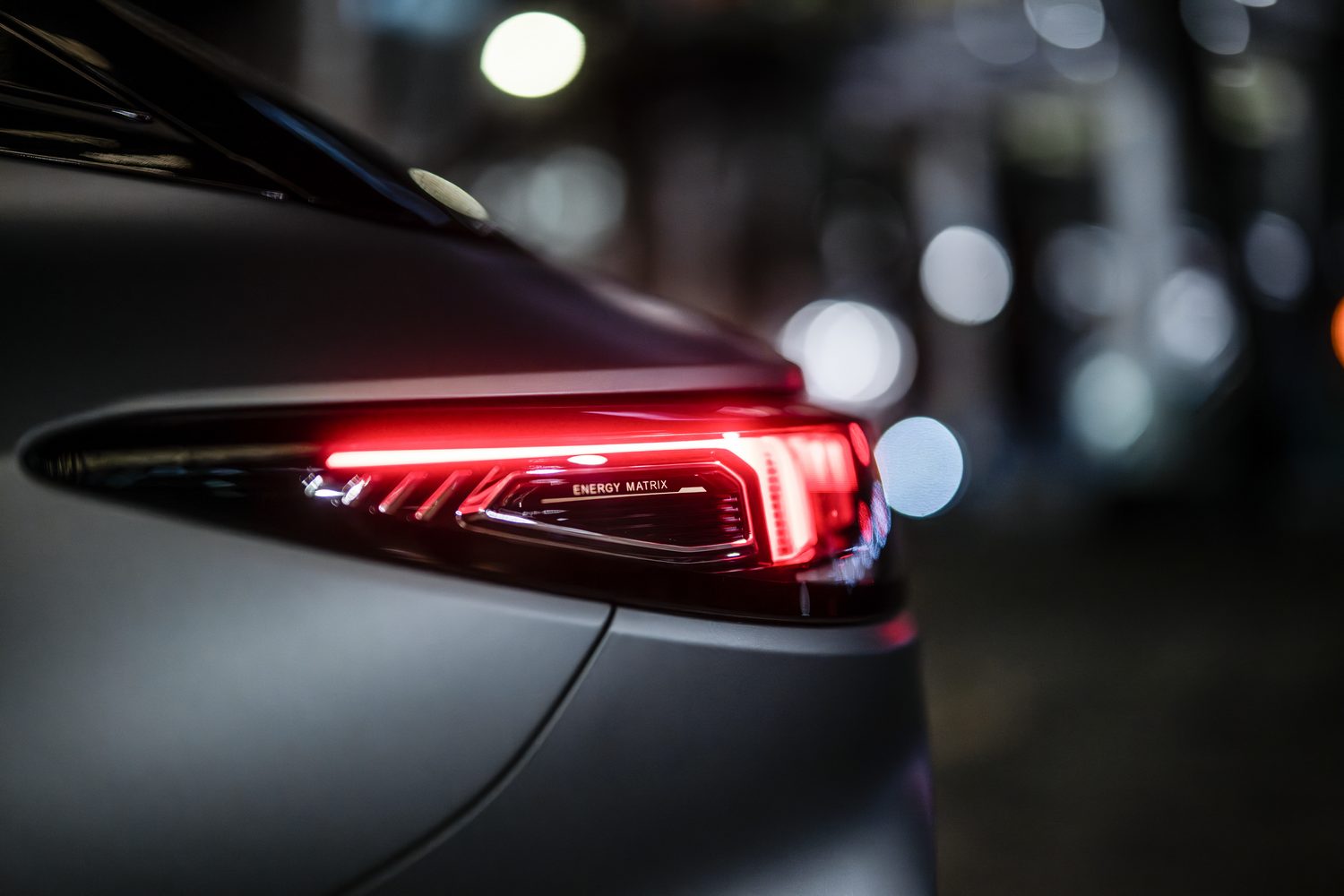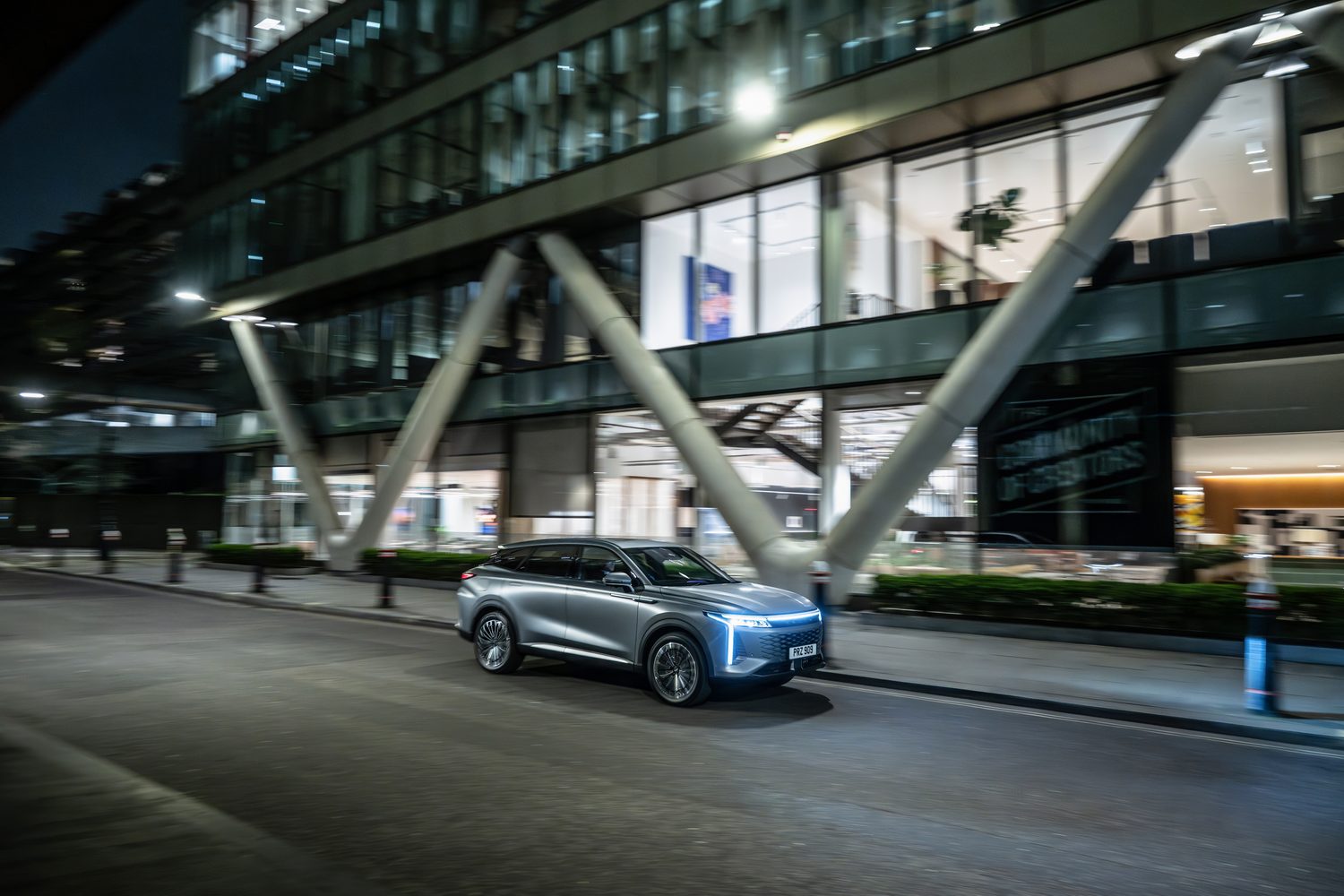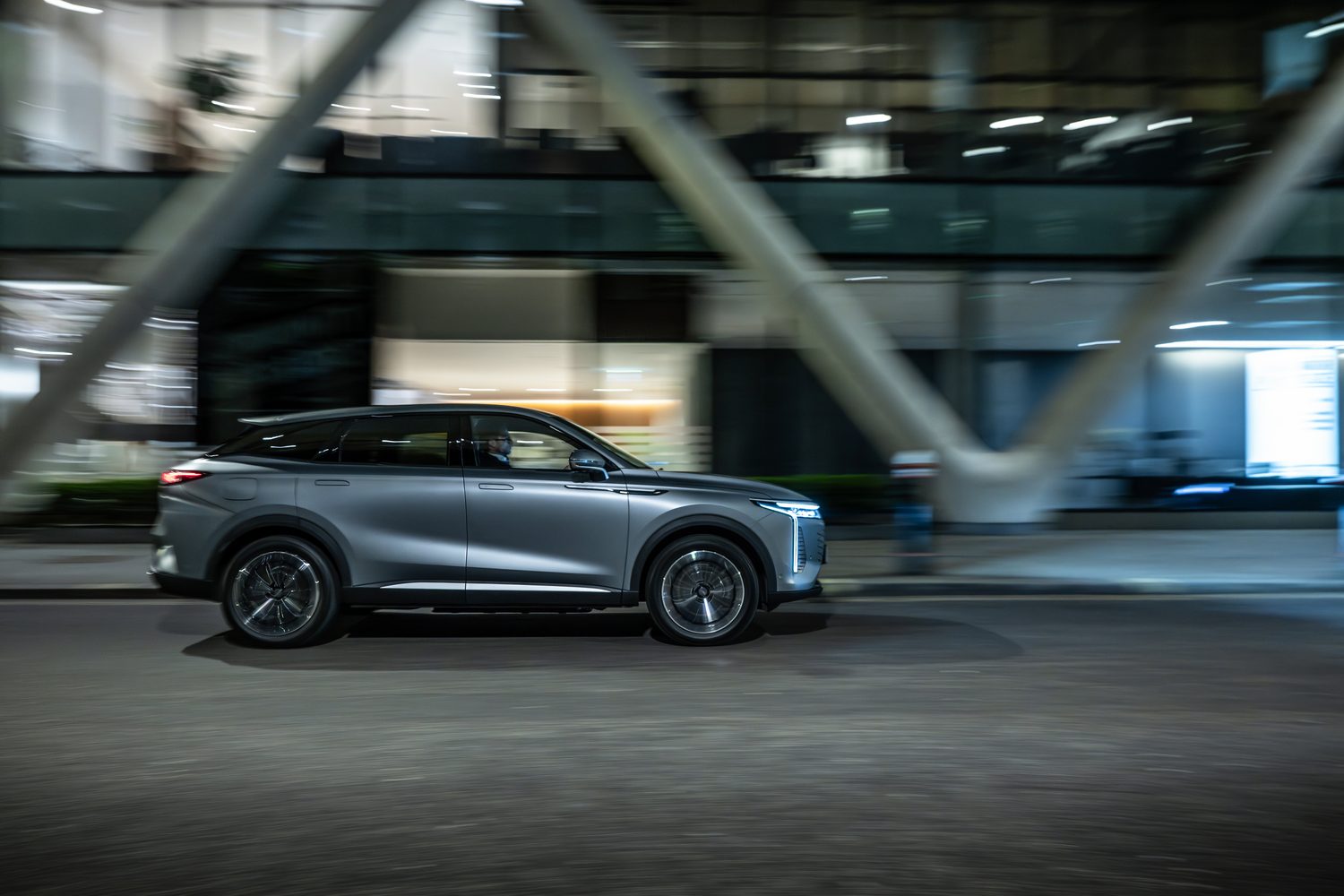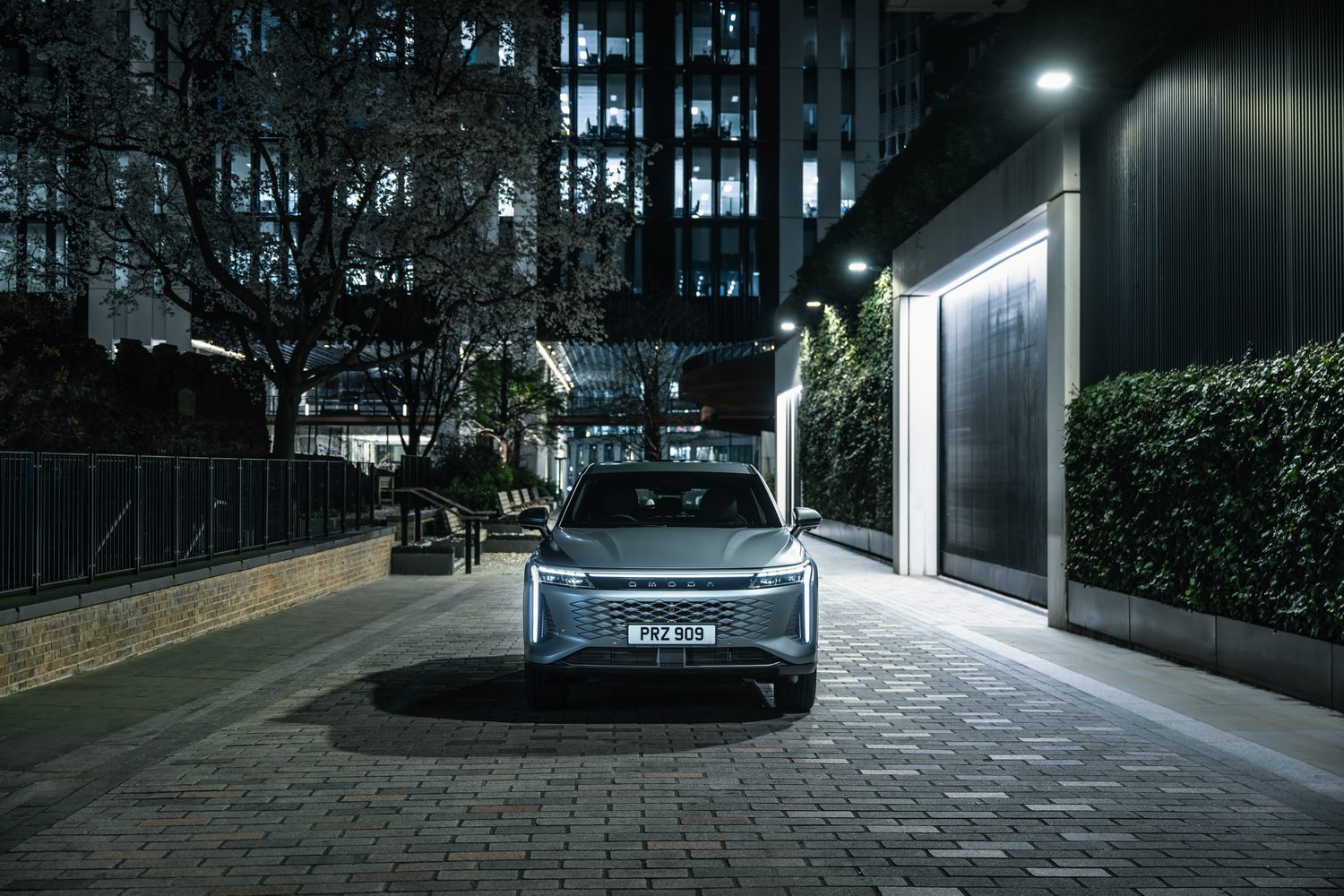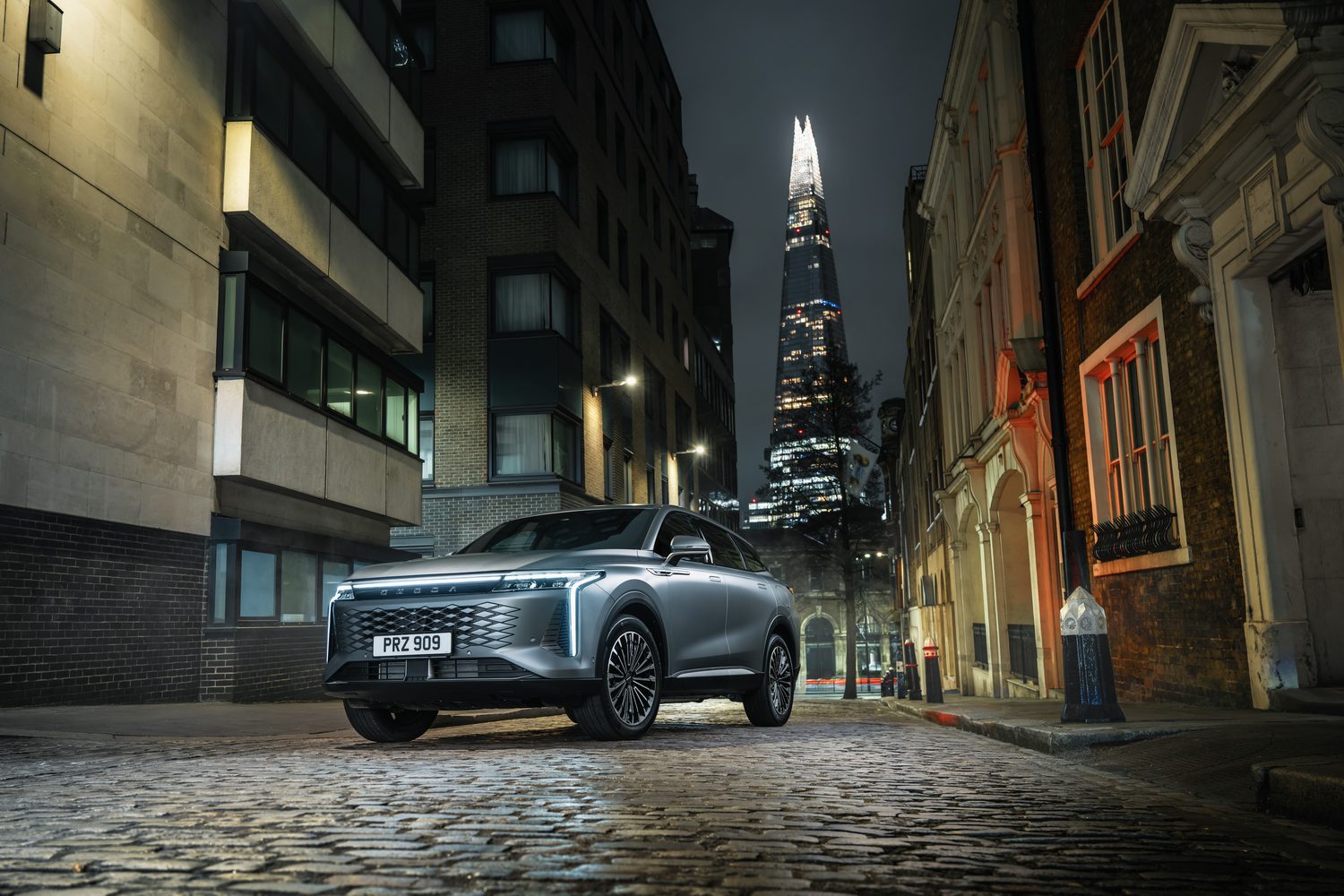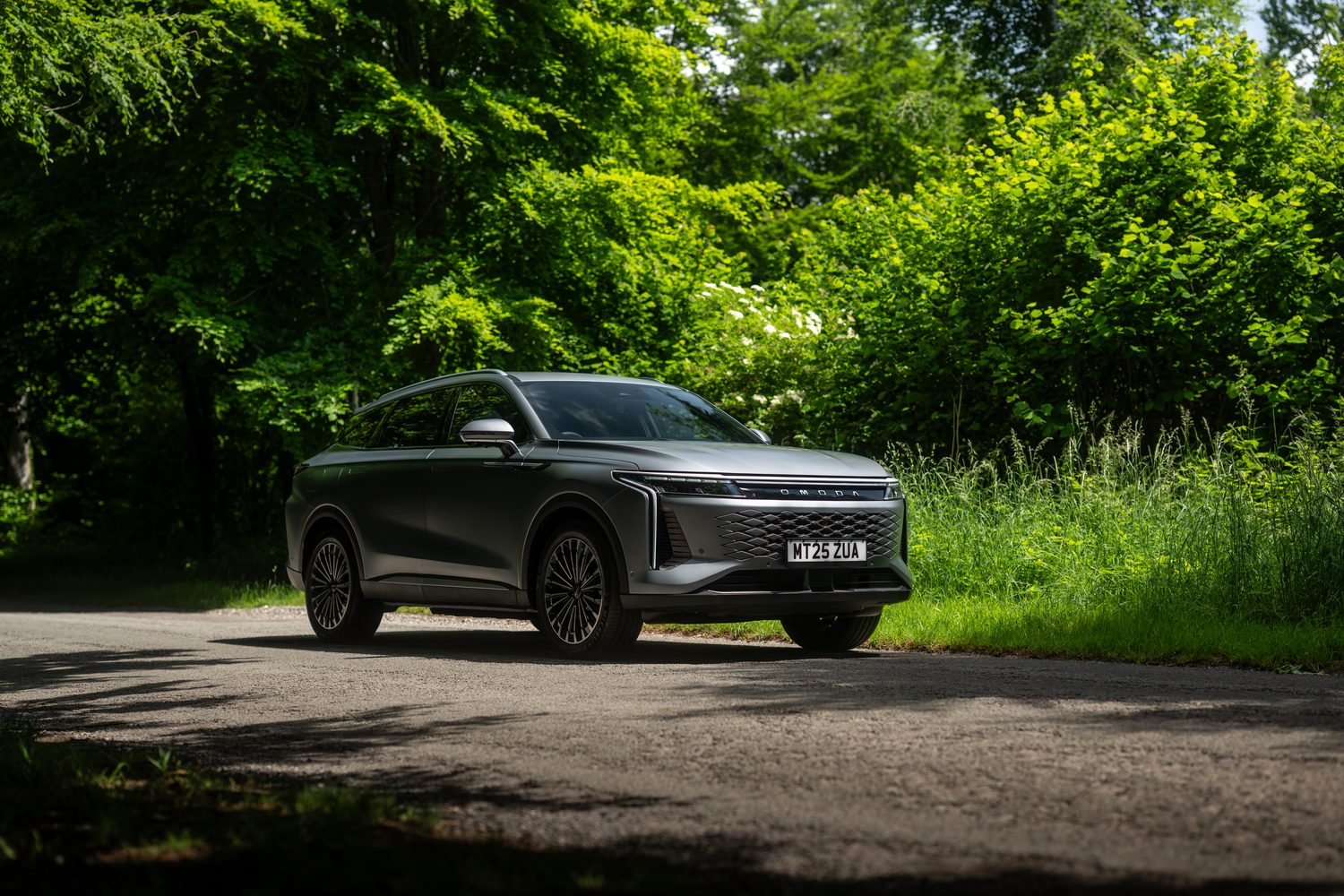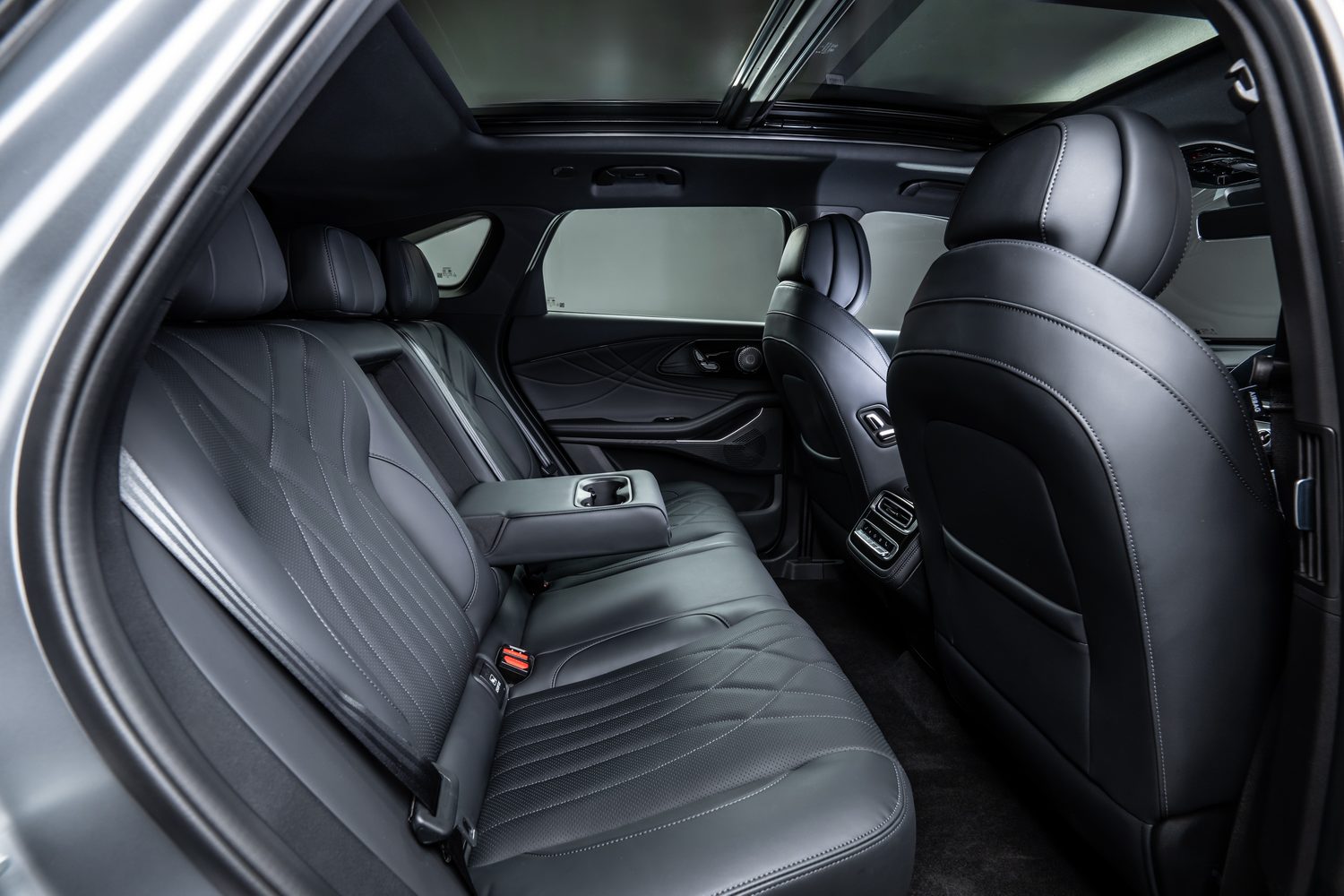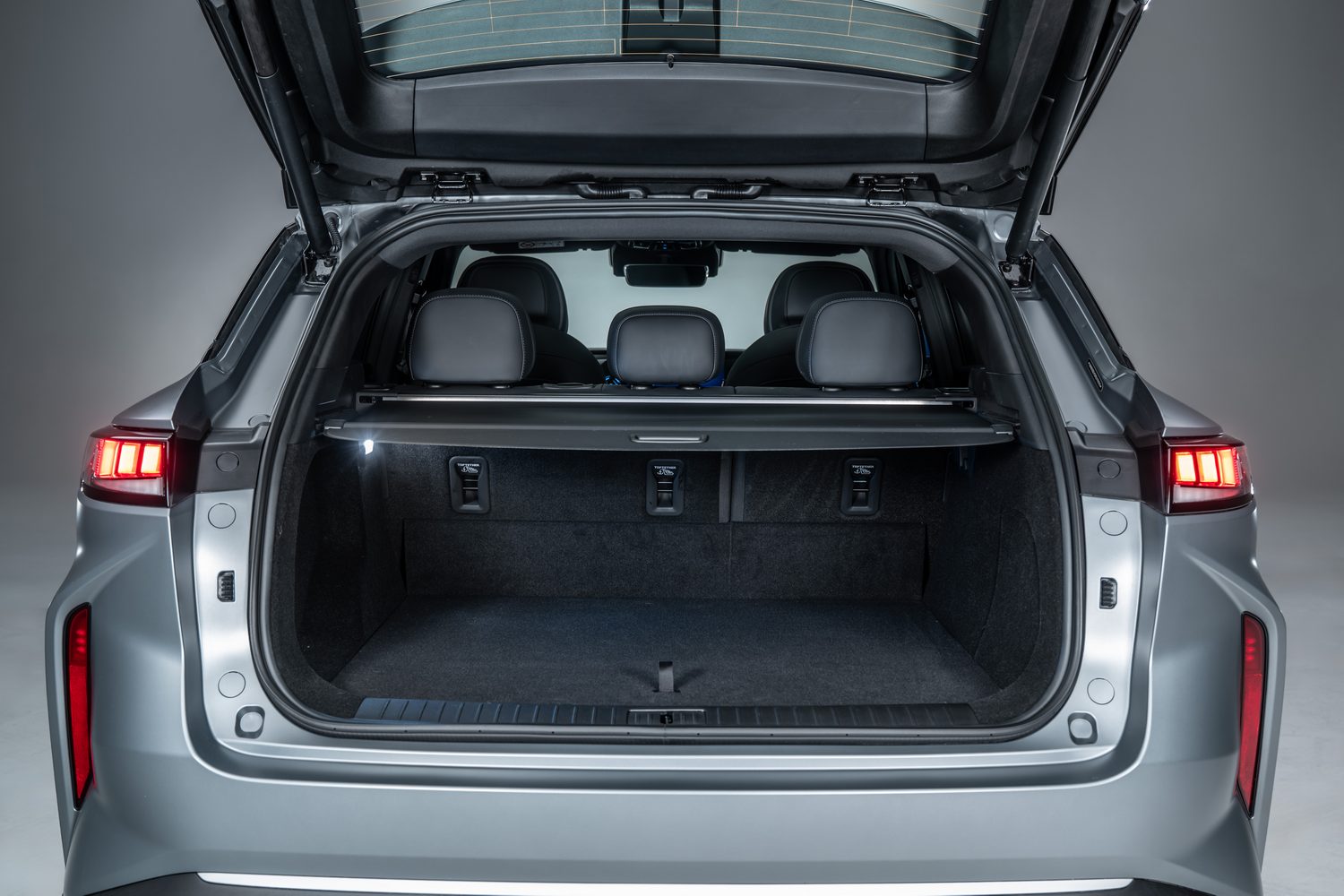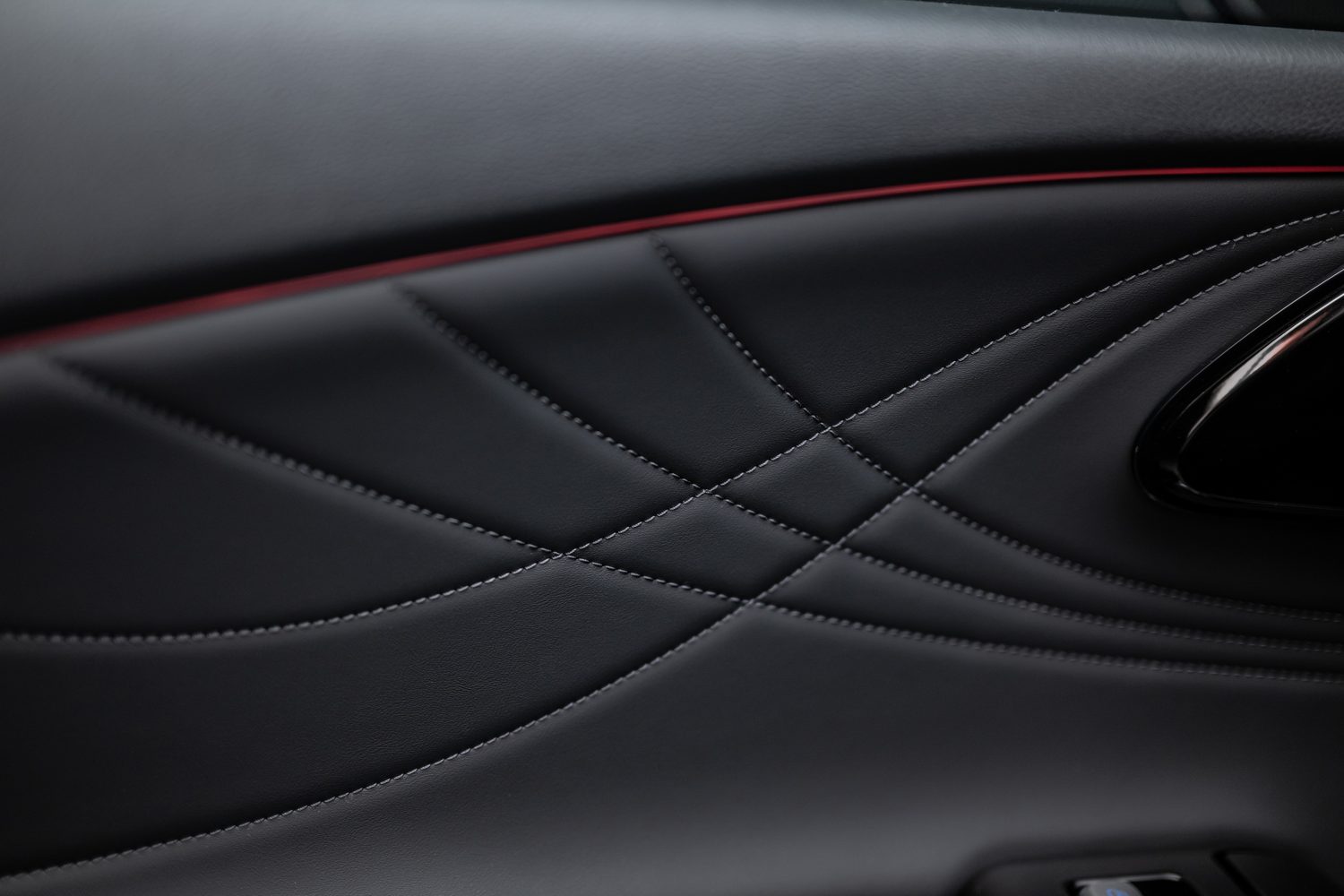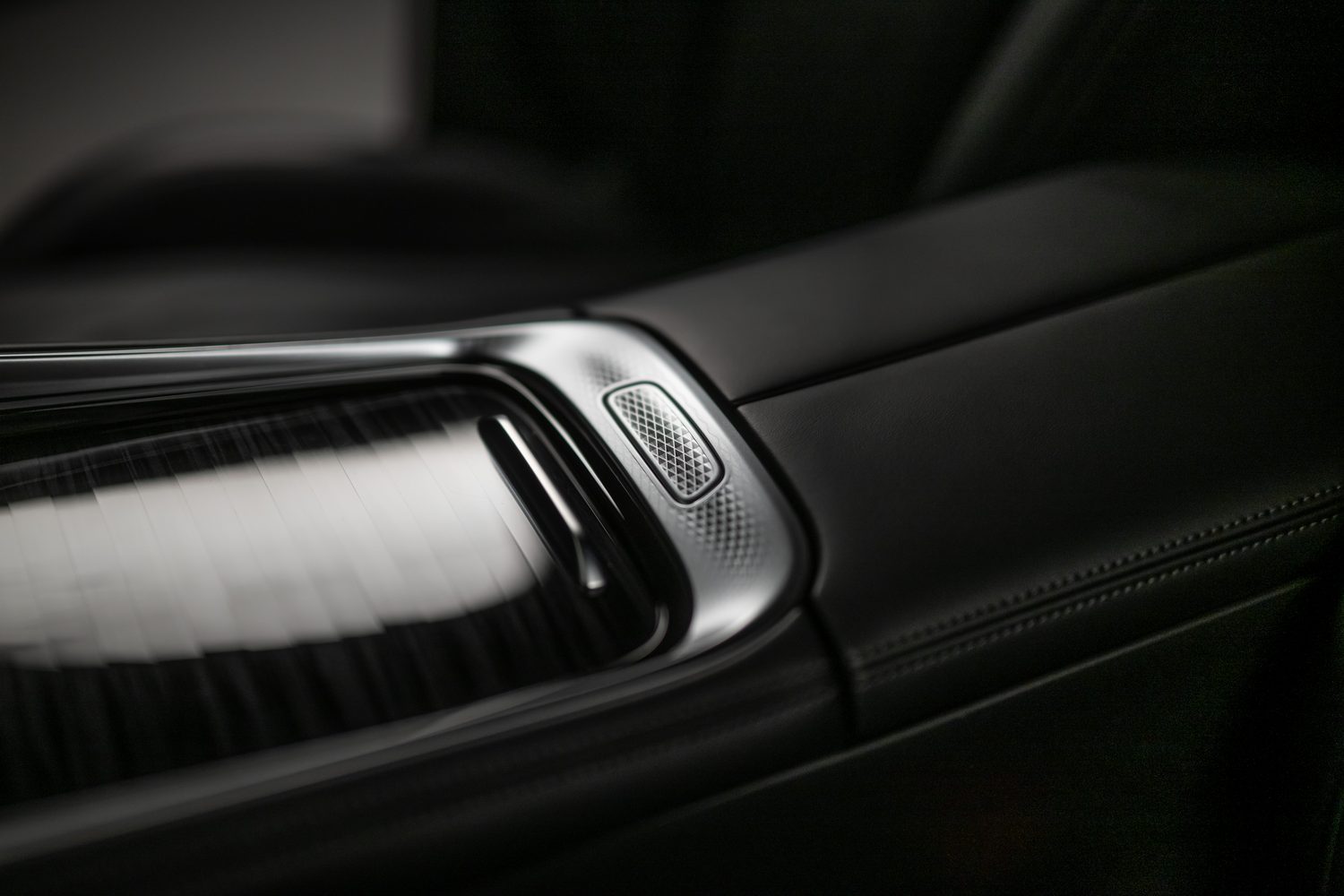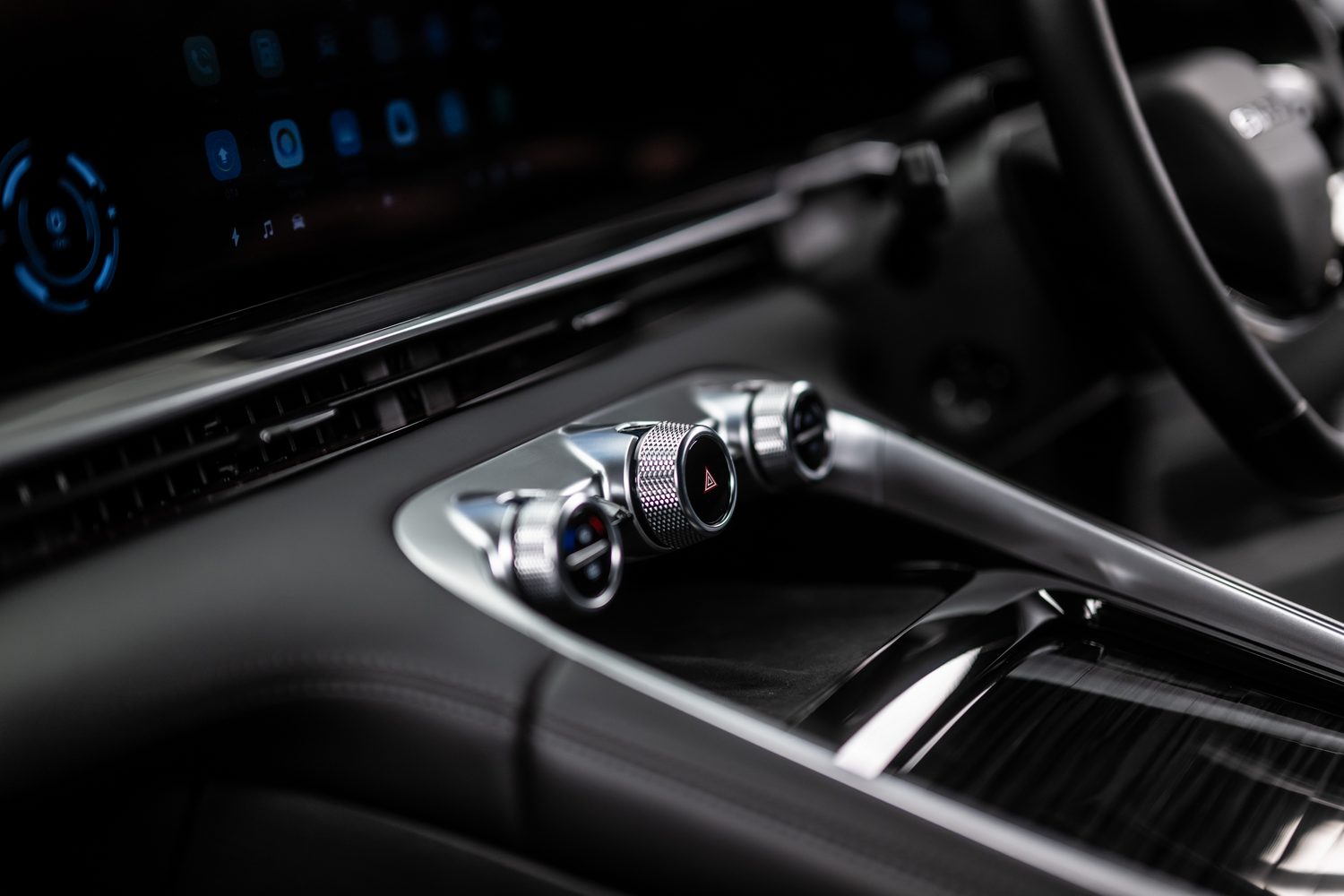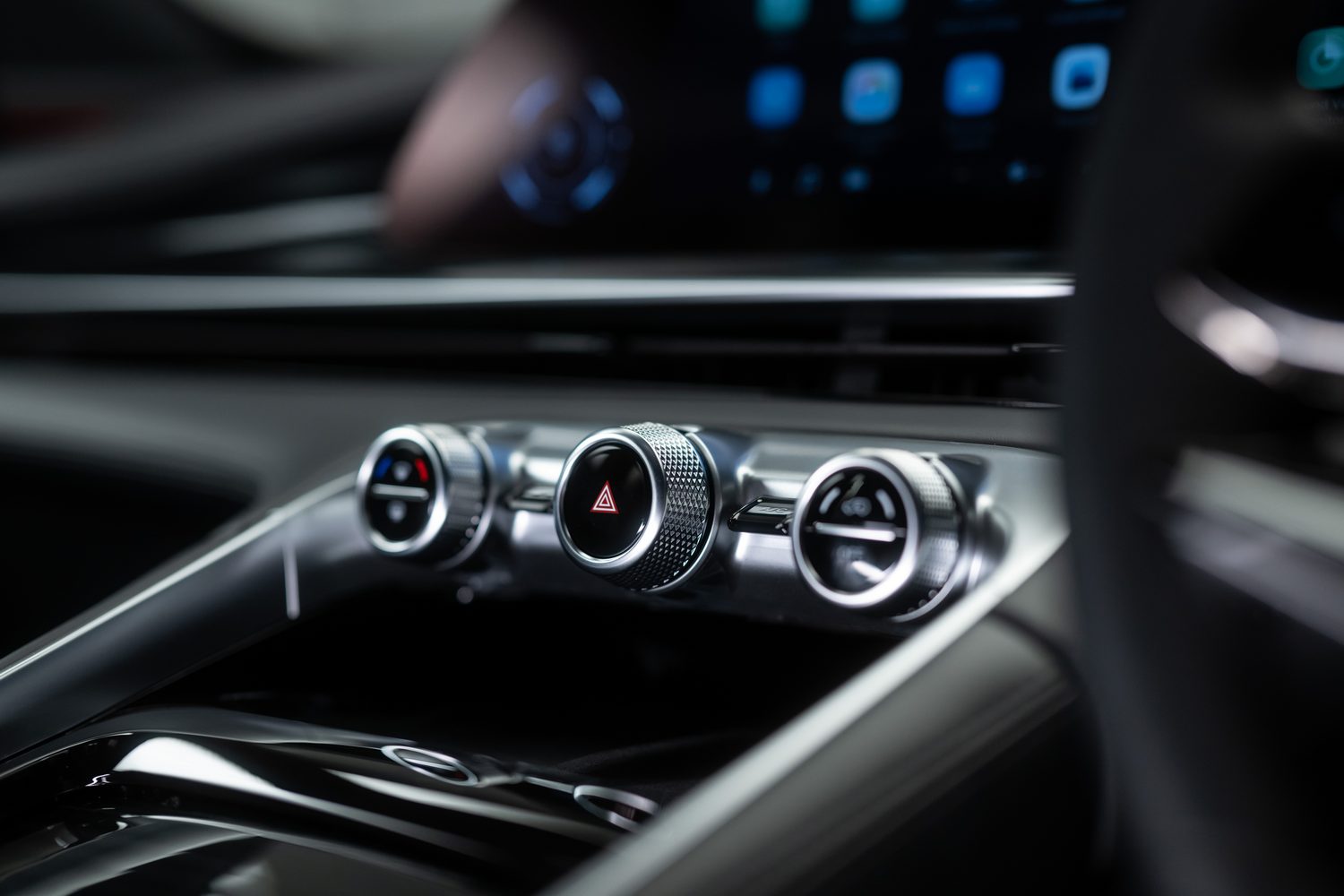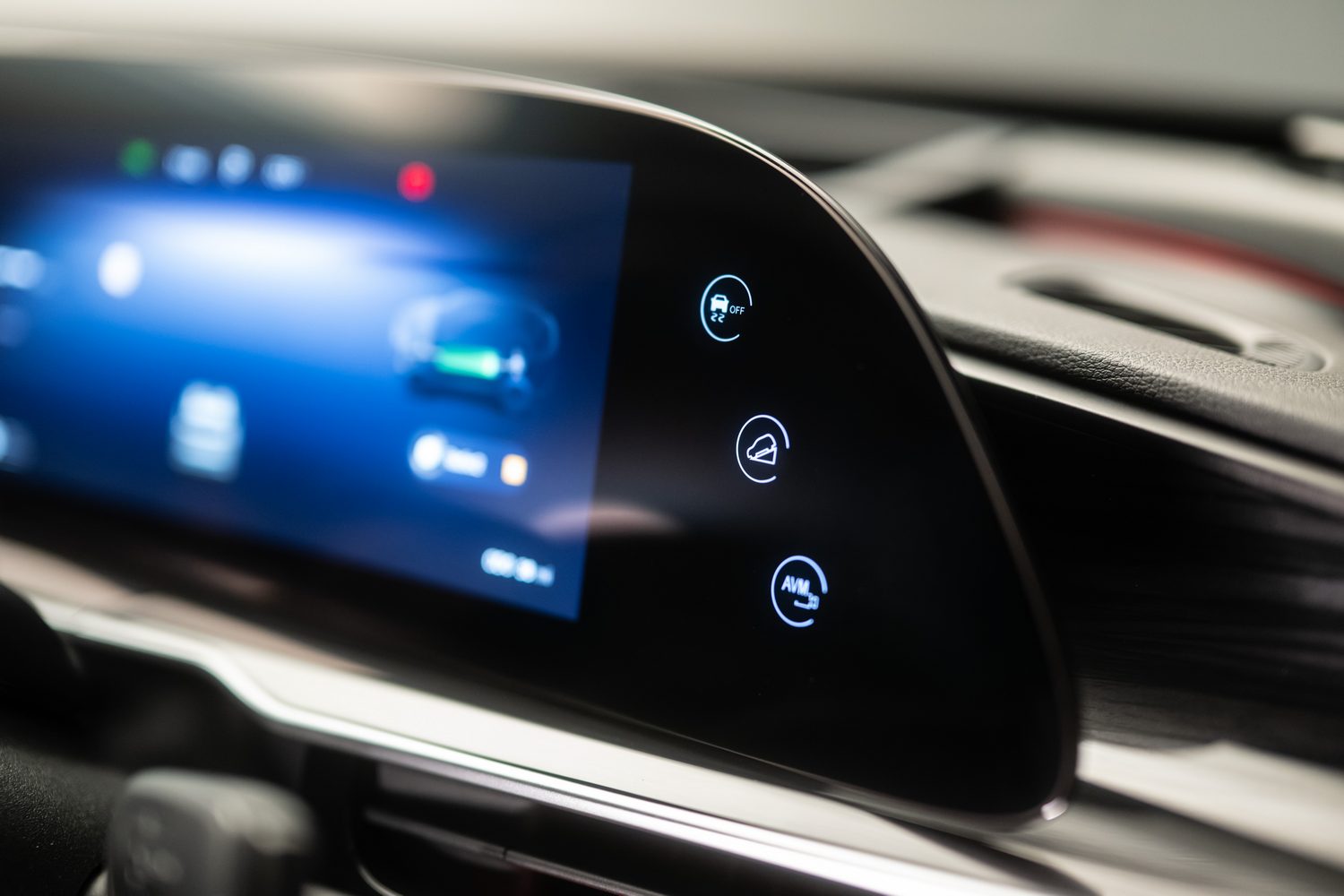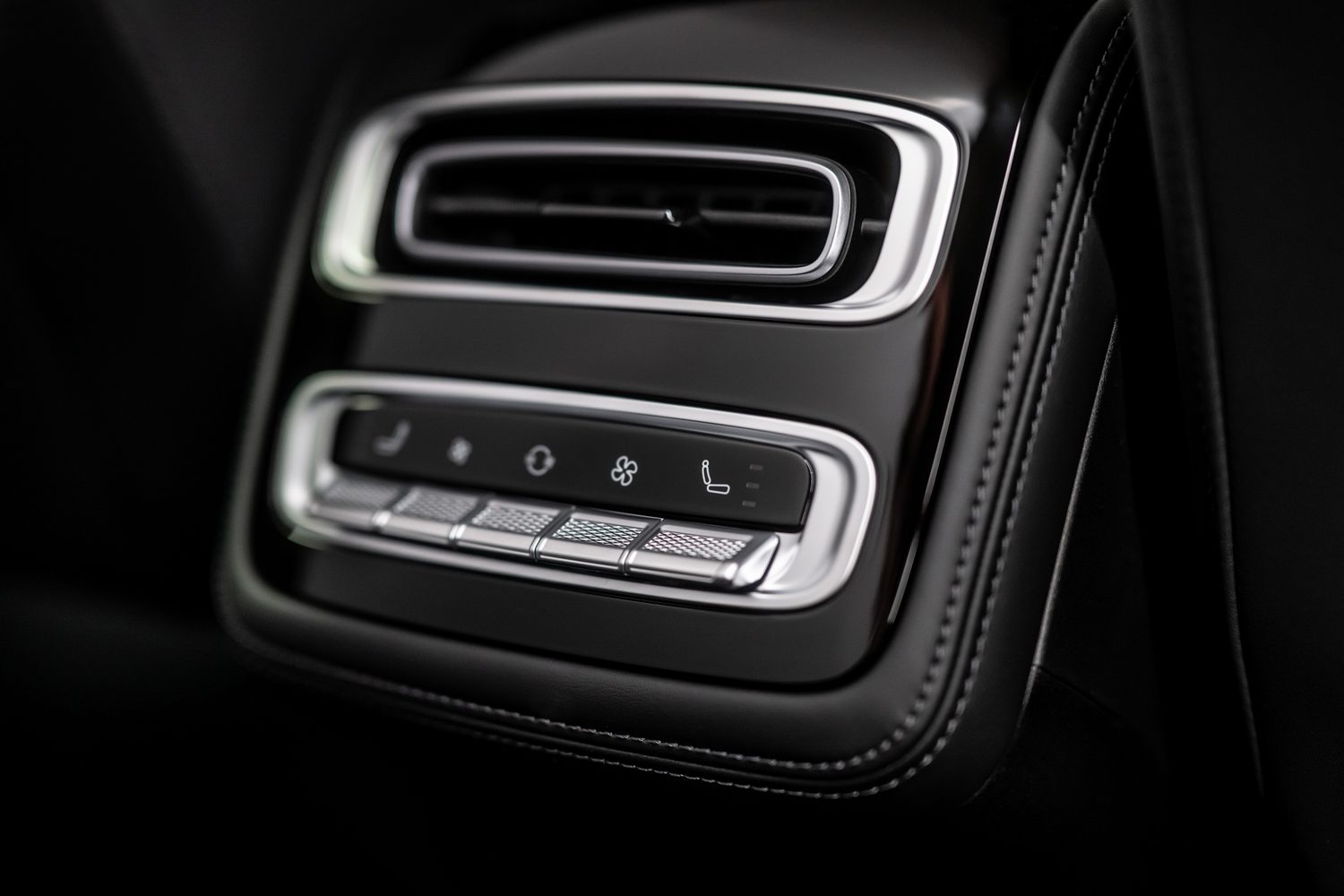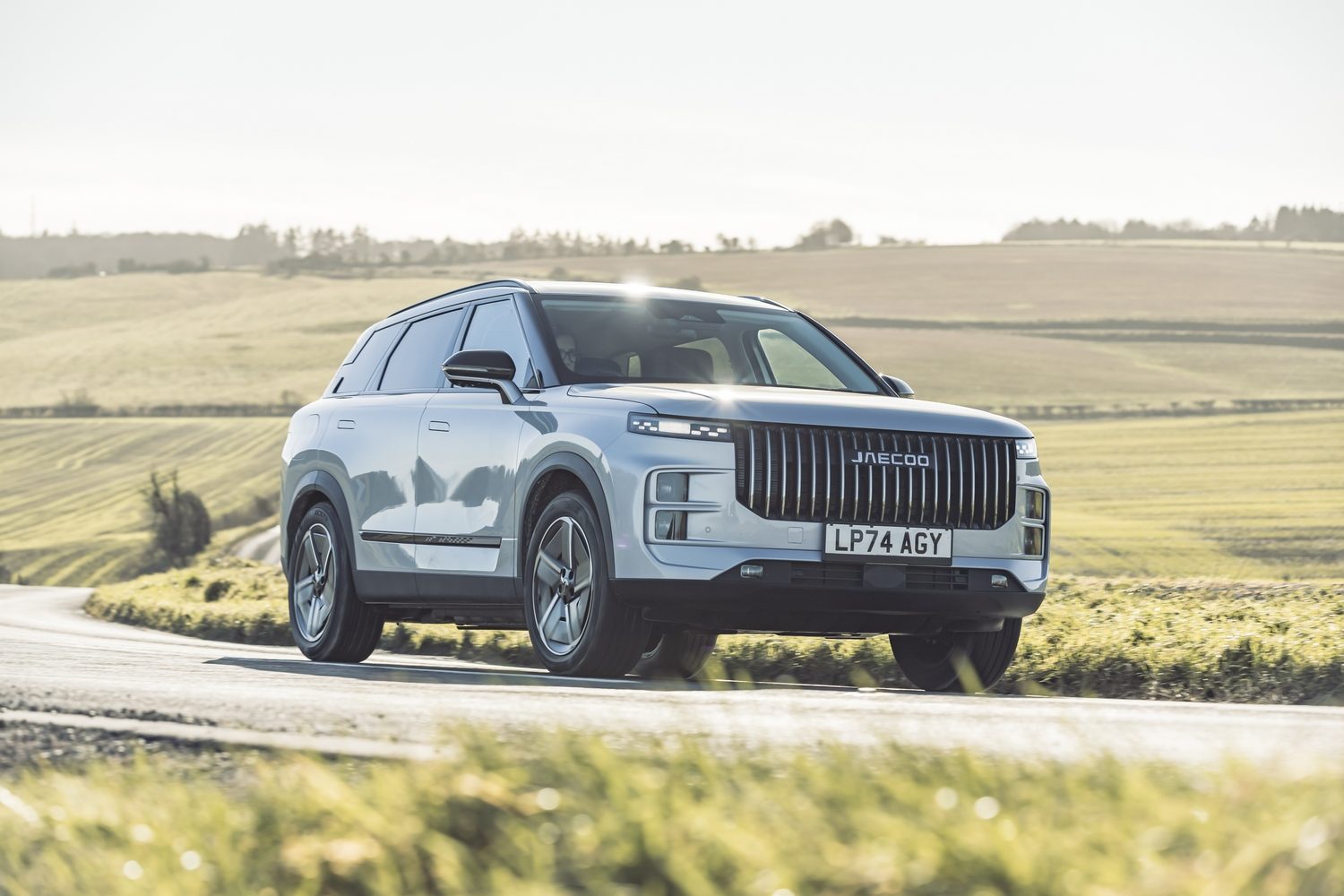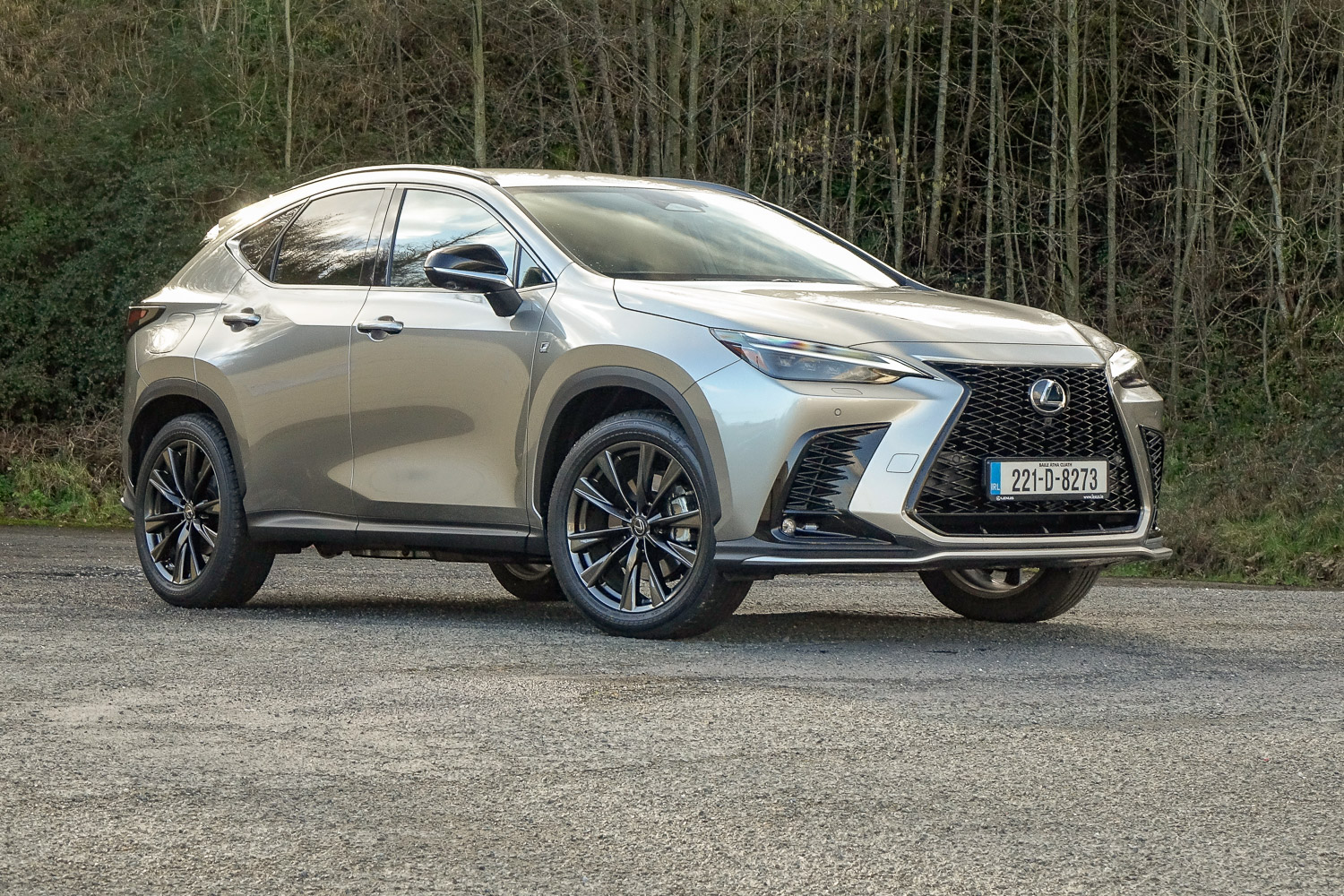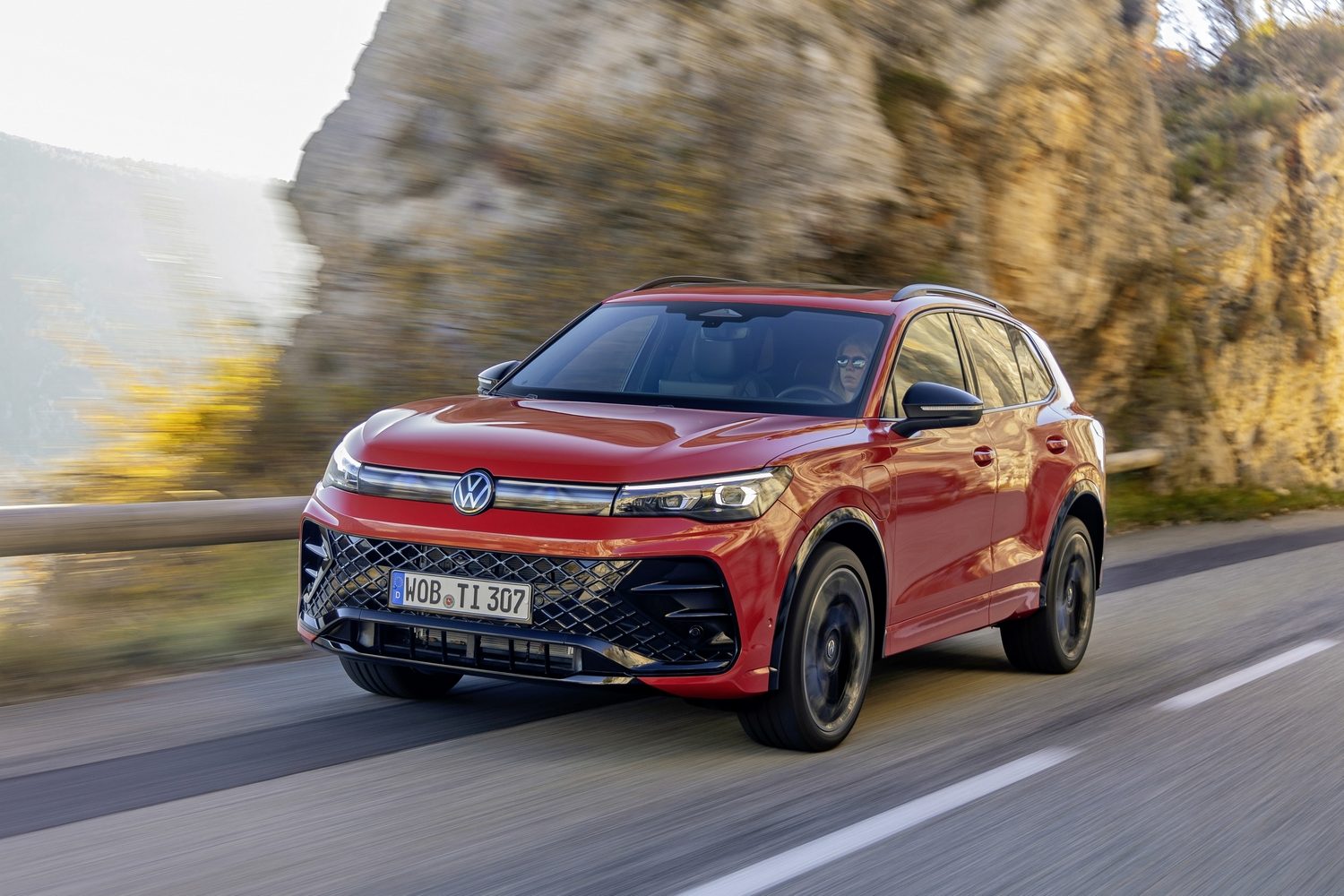Introduction to the 2025 Omoda 9 SHS
Omoda is one of two fledgling car brands from the Chery group in China, along with related firm Jaecoo. But whereas the latter has products which place the emphasis on ruggedness and off-roading prowess, the former aims to target “urban luxury”.
We've already reviewed the smaller, all-electric Omoda E5 SUV, but with the company's arrival in Ireland still not yet confirmed, now we're getting a go in its flagship 9 SHS model. This is a large SUV that aims to, from a physical, equipment and finishing standpoint, go toe-to-toe with the likes of the BMW X3, Lexus NX and Volvo XC60, but which should be priced like a Skoda Karoq, Nissan Qashqai or Peugeot 3008.
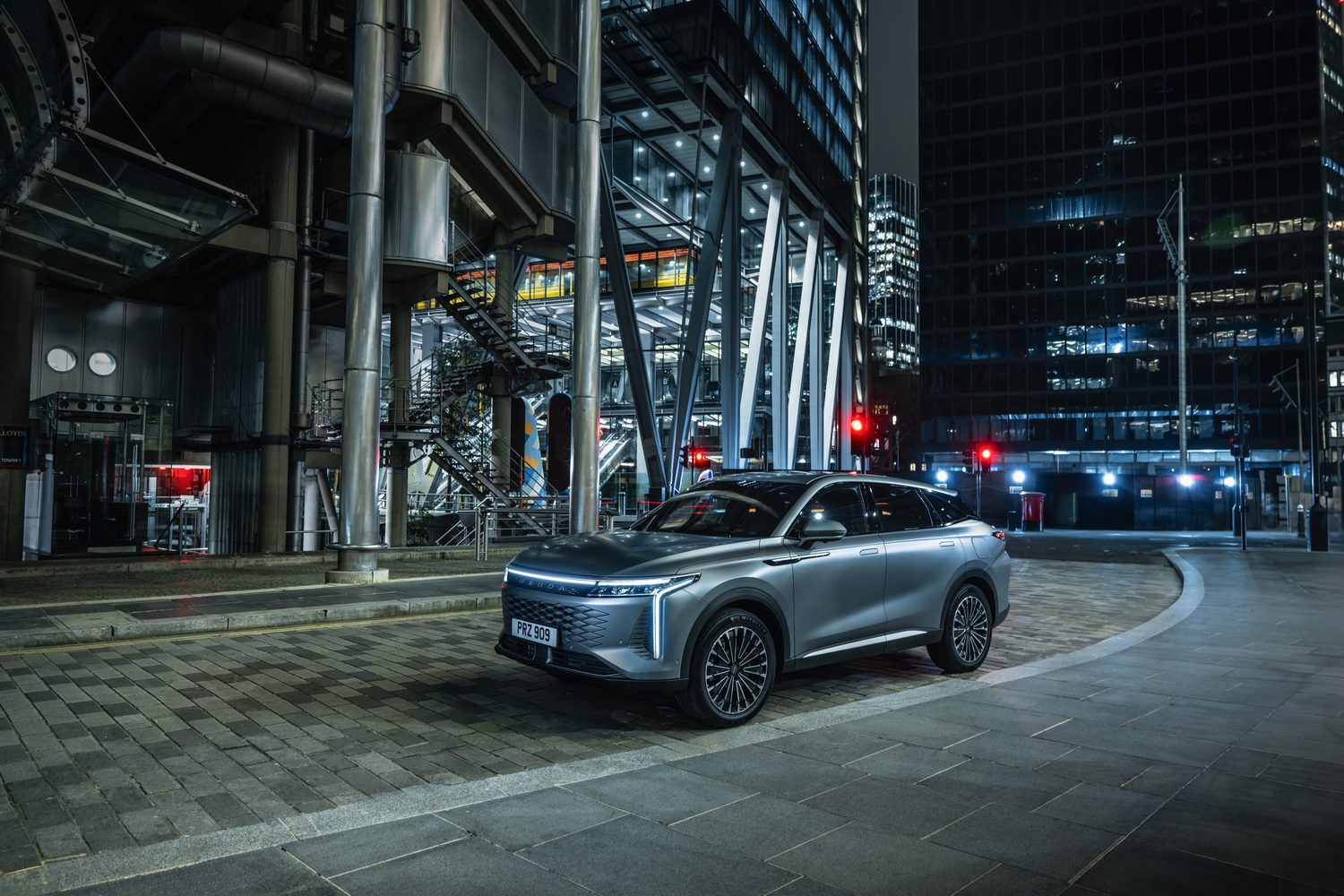
And SHS means this is not an all-electric car, but a plug-in hybrid, complete with a claimed combined petrol-electric range of more than 1,200km. We headed over to the UK to try the 9 SHS out for size, to see if Irish buyers should be pushing for Omoda's launch on our shores sooner rather than later.
Pros & Cons of the 2025 Omoda 9 SHS
Pros: Strong performance, impressive range, high-quality cabin
Cons: Dead-feeling brakes, irksome infotainment
Exterior & Design of the 2025 Omoda 9 SHS
• Styling informed by 'the golden ratio'
• Attractive, albeit not distinctive, form
• Suitably aerodynamic
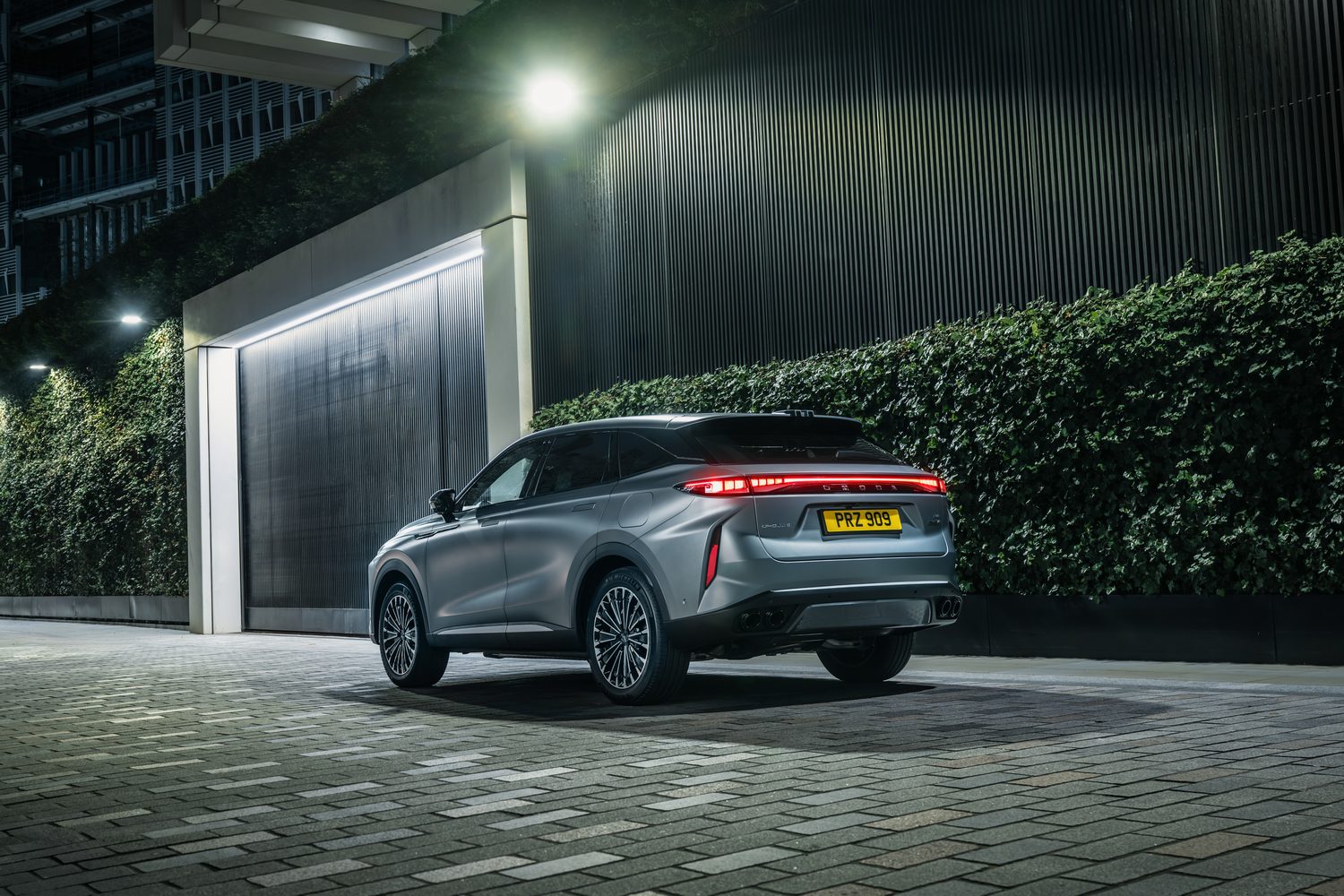
The appearance of the Omoda 9 is said to adhere to the golden ratio, which is 1.618 if you're interested. In plain language, there's about two-thirds metal to one-third glass when you look at this new SUV. And that makes it easy on the eye according to Omoda.
We'd not argue with that, even though there's more than a whiff of Lexus RX about the swooping roofline, C-pillar treatment and look of the full-width rear light array on the Omoda 9, but it's not slavishly derivative of any one car and has a fair sense of purpose to it when we're talking kerb appeal.
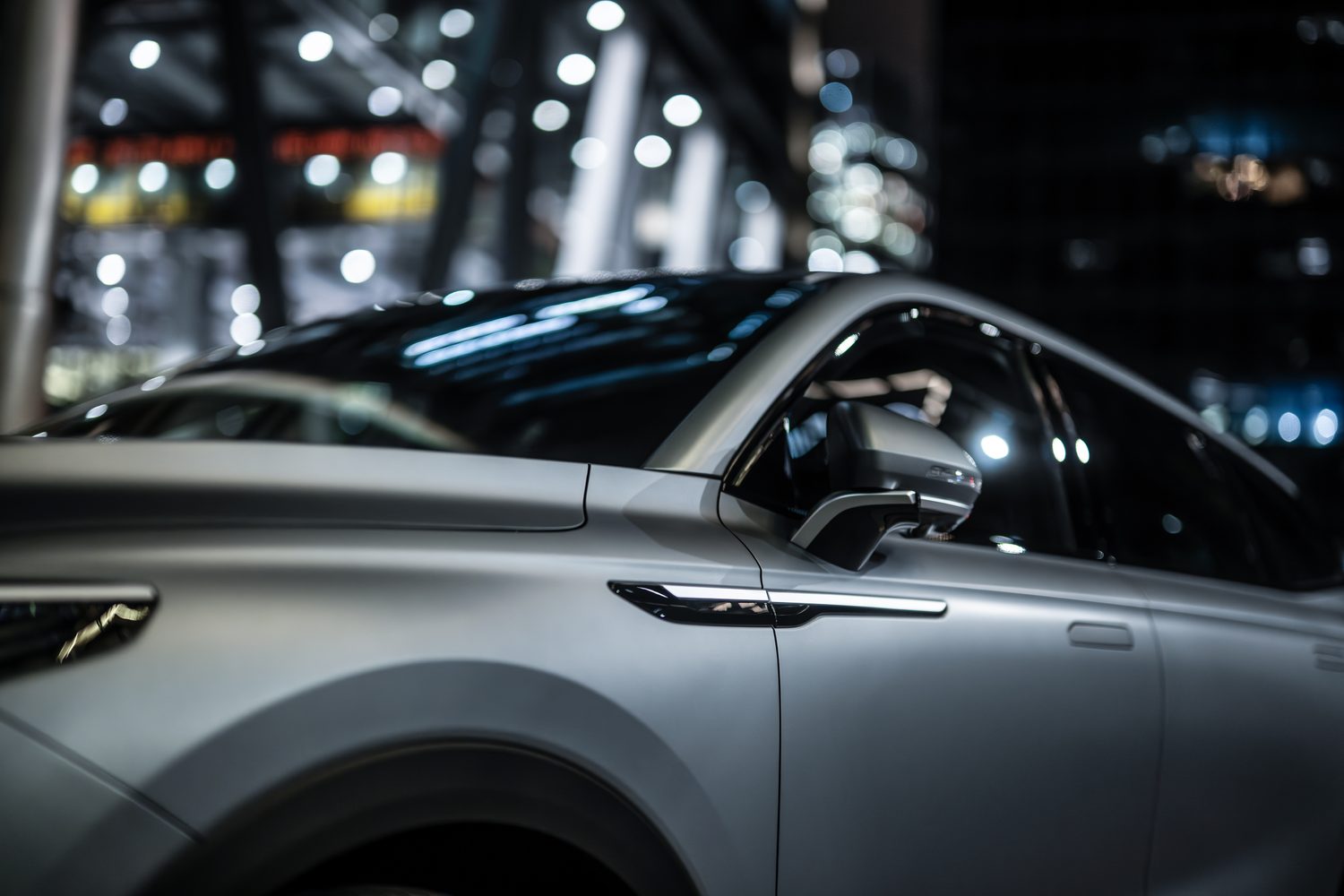
That big, distinctive light signature on its nose, sweeping side-to-side and then running vertically at the outer edges, helps to give the SHS some definable character. And its sleek shape, despite its size, results in an admirable coefficient of drag of 0.308.
The Omoda 9 SHS's dimensions are:
Length: 4,775mm
Width: 1,920mm
Height: 1,671mm
Wheelbase: 2,800mm
It's quite a big machine, but it's not offered as a seven-seater. And if the (eventual) Irish-market cars follow the pattern of the UK, then the 9 SHS will come in just five colours: Quartz White, Andesite Grey, Onyx Black, Peridot Green and Hawk's Eye Grey. Of these, white is the standard colour and Hawk's Eye is the single most expensive upgrade option. The Omoda also runs on 20-inch alloys as standard.
Interior, Practicality, Tech & Comfort of the 2025 Omoda 9 SHS
• Good standard of finishing
• Loads of space and equipment
• Infotainment needs work
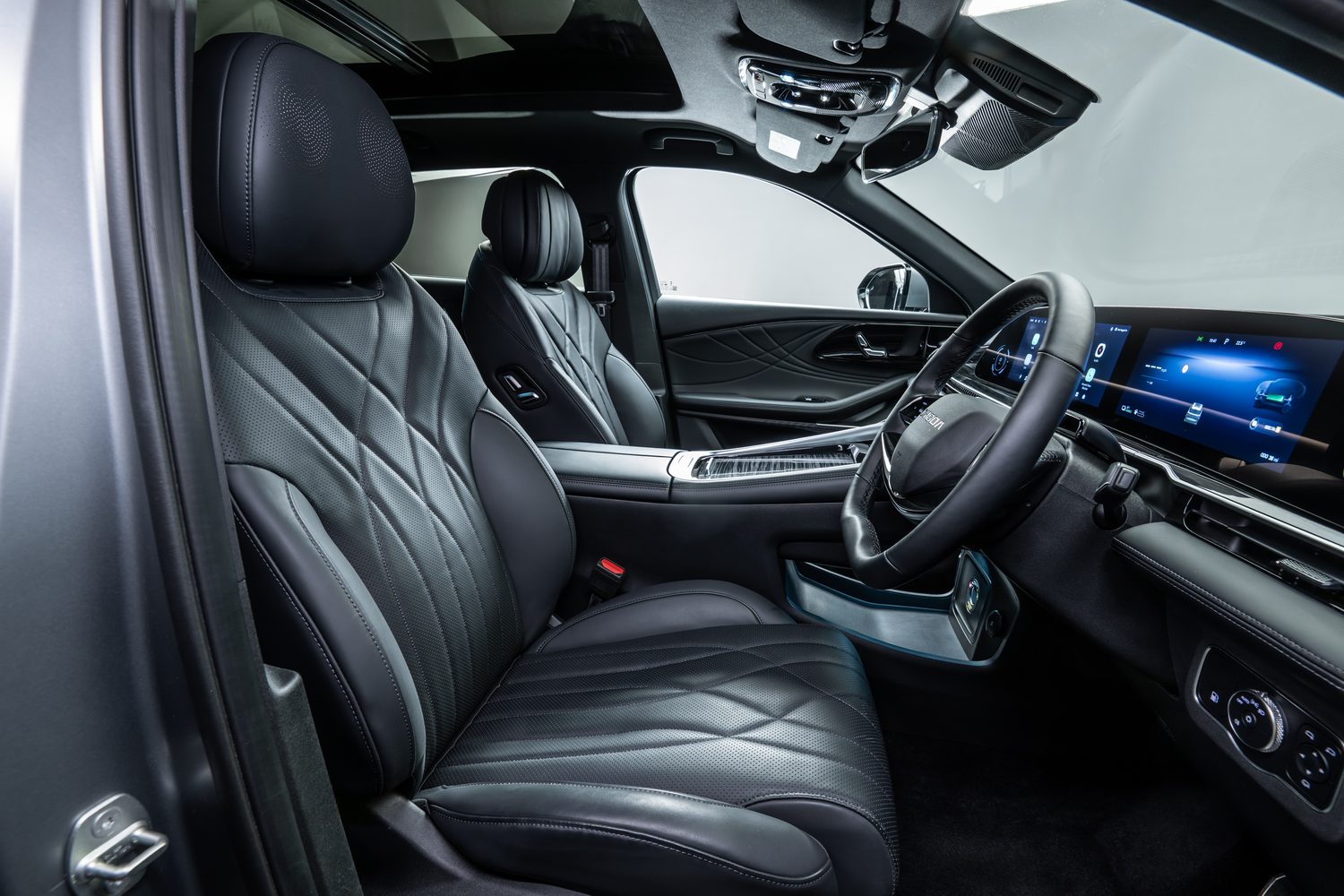
Chinese manufacturers looking to get a foothold in European markets where there is a lot of talented, established opposition often offer plenty of car and equipment for a significantly reduced amount of money. That doesn't always mean the best interiors can be found in machines from the Asian country, but in the case of the Omoda 9 we're happy to report this is one of the more successful cabins to issue forth from China.
Material finishing is, broadly, excellent, with few glaringly deficient haptics to report, while on the other hand the Omoda 9 looks good as soon as you step in. This is not a boring and featureless fascia, punctuated by a massive screen-based infotainment system.
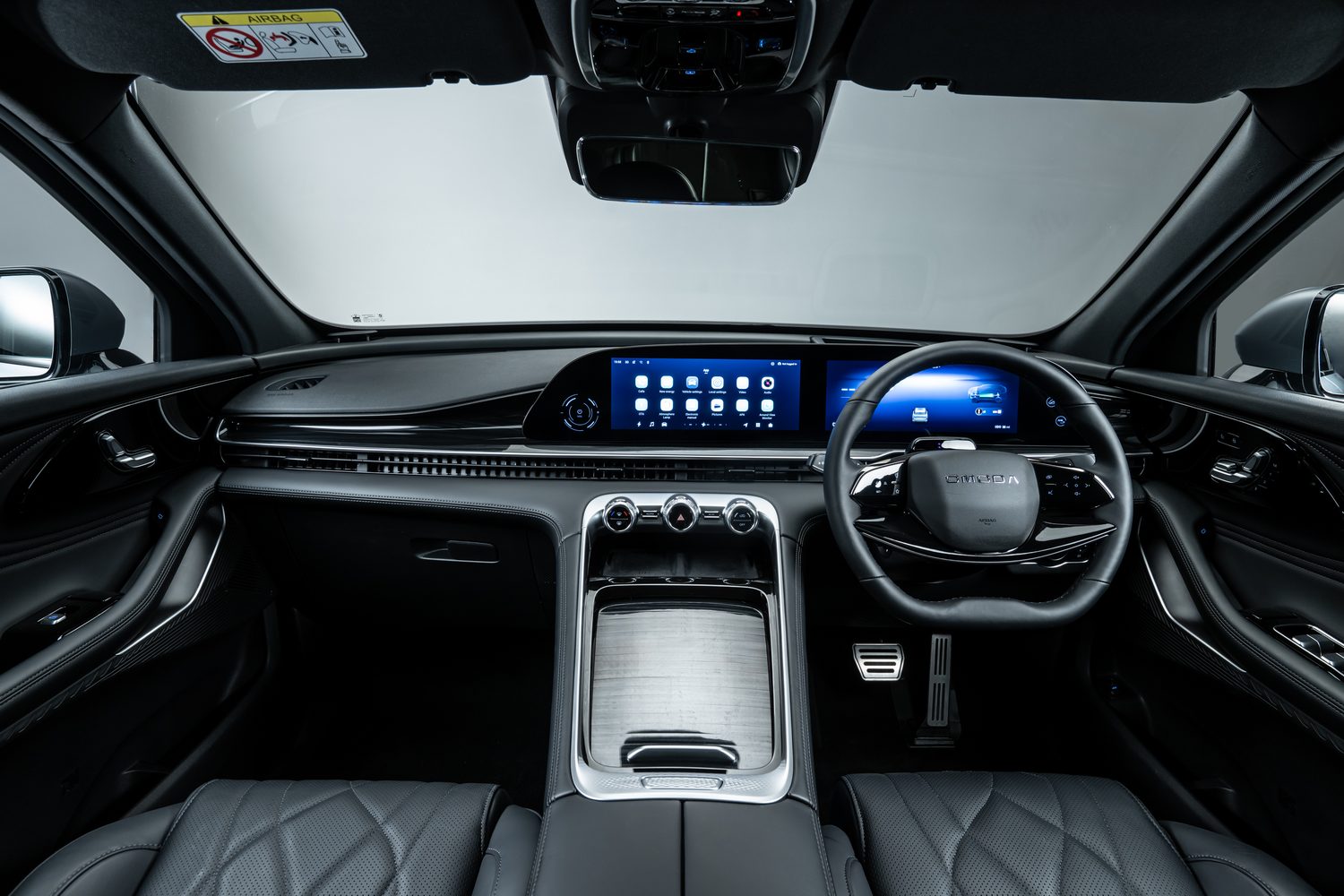
Well... we say that, of course, but your eye will surely be drawn to the 24.6-inch curved display which houses the central touchscreen and the digital instrument cluster. Anyway, we'll leave that for a minute to return to the general ambience, which is pleasant. Fancy stitching patterns on the synthetic-leather seats and door cards give the impression of something upmarket, while the large, raised centre console further defines the cabin shape. There's a strip of air vents neatly incorporated into the mix, too, while Omoda is proud to say there are 53 items of physical switchgear and buttons dotted throughout the interior of the 9 SHS.
So far, so good; it all looks and feels great. However, a few issues do soon present themselves. Such as the driver's seat, which does not electrically adjust low enough in the car relative to the headlining and window lines, so you feel as if you're teetering up high relative to the body of the Omoda, rather than being ensconced by it. Some people will like this, as that's why they're buying an SUV in the first place - to sit high up - but there's a crucial difference in any car, no matter how tall it is on the outside, when it comes to the seat being mounted low down or not.
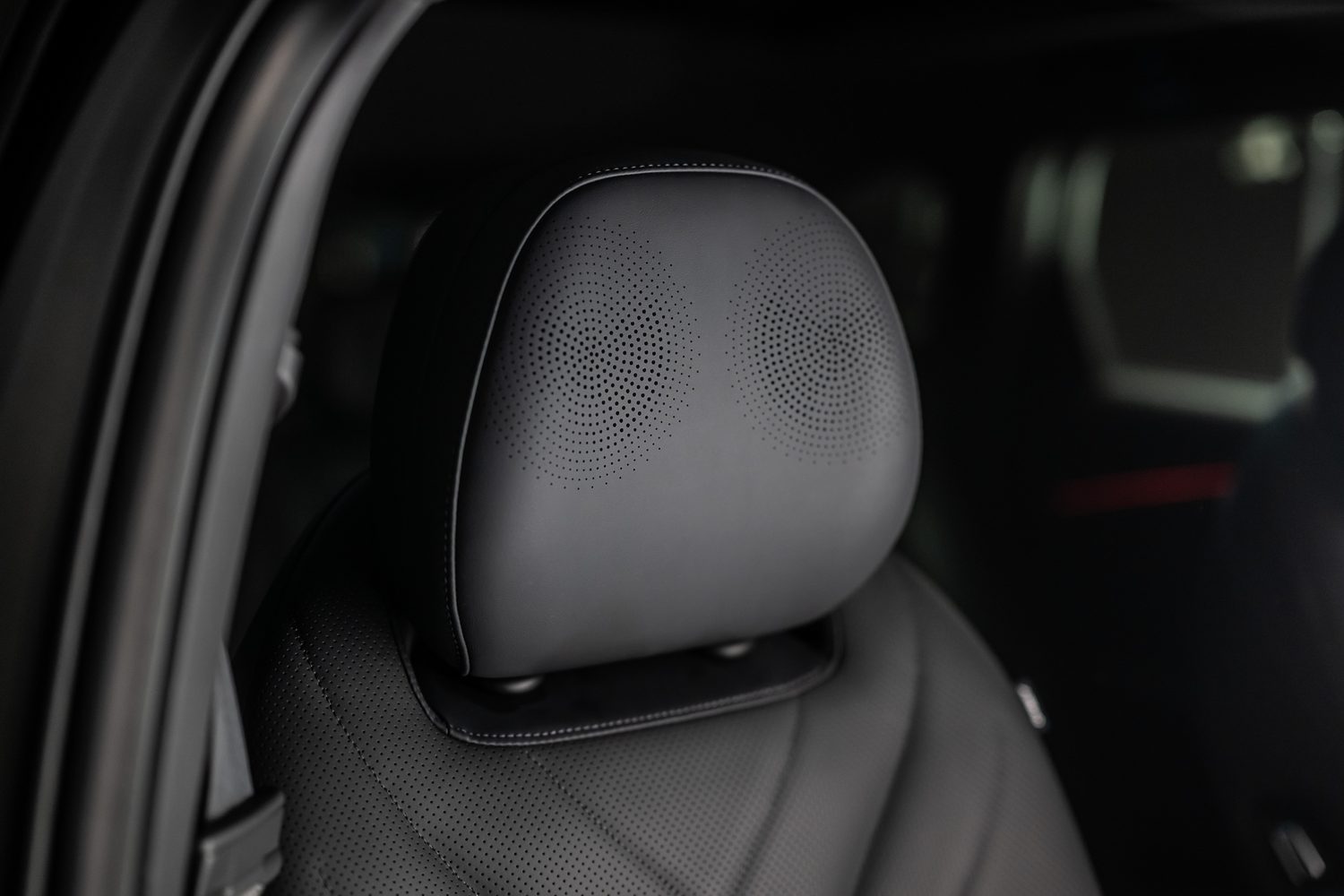
It's also not the most comfortable chair, feeling a little too firm in the buttocks area. Those seats in the front look plush, but after an hour and more behind the wheel, they certainly didn't feel it. A little more padding or give in this region (the seat base, not the... oh, never mind!) might help matters.
And then there's the infotainment. Graphically, it's more than sharp enough and there's plenty of real estate to display icons and the like on it, so it's largely OK. The issue is that the menus are all confusing, specifically in terms of how it clusters the vehicle settings together, and there can be some lag when tapping on the screen. You can bypass it, of course, with wireless Apple CarPlay and Android Auto technology, which many people will do out of choice anyway, but it's a shame the proprietary system isn't a little sharper.
Also, the Omoda 9 has a truly daft trip computer which only ever shows you the last 50km of your fuel economy and electrical consumption. Why can't you just reset this, like you can on almost any other car in the world? And why does it also give an overall fuel economy for the hybrid drivetrain, before then splitting it down into two more gauges for individual petrol and battery use... only subsequently giving a flattering figure for both that cannot possibly add up to the overall number, because each individual read-out is augmented by the other portion of the drivetrain, if you get us. As in, we were driving along with an overall 47.9mpg showing but the car reckoned the petrol engine was doing 108.7mpg, while the battery was averaging a phenomenal 5.8 miles/kWh.
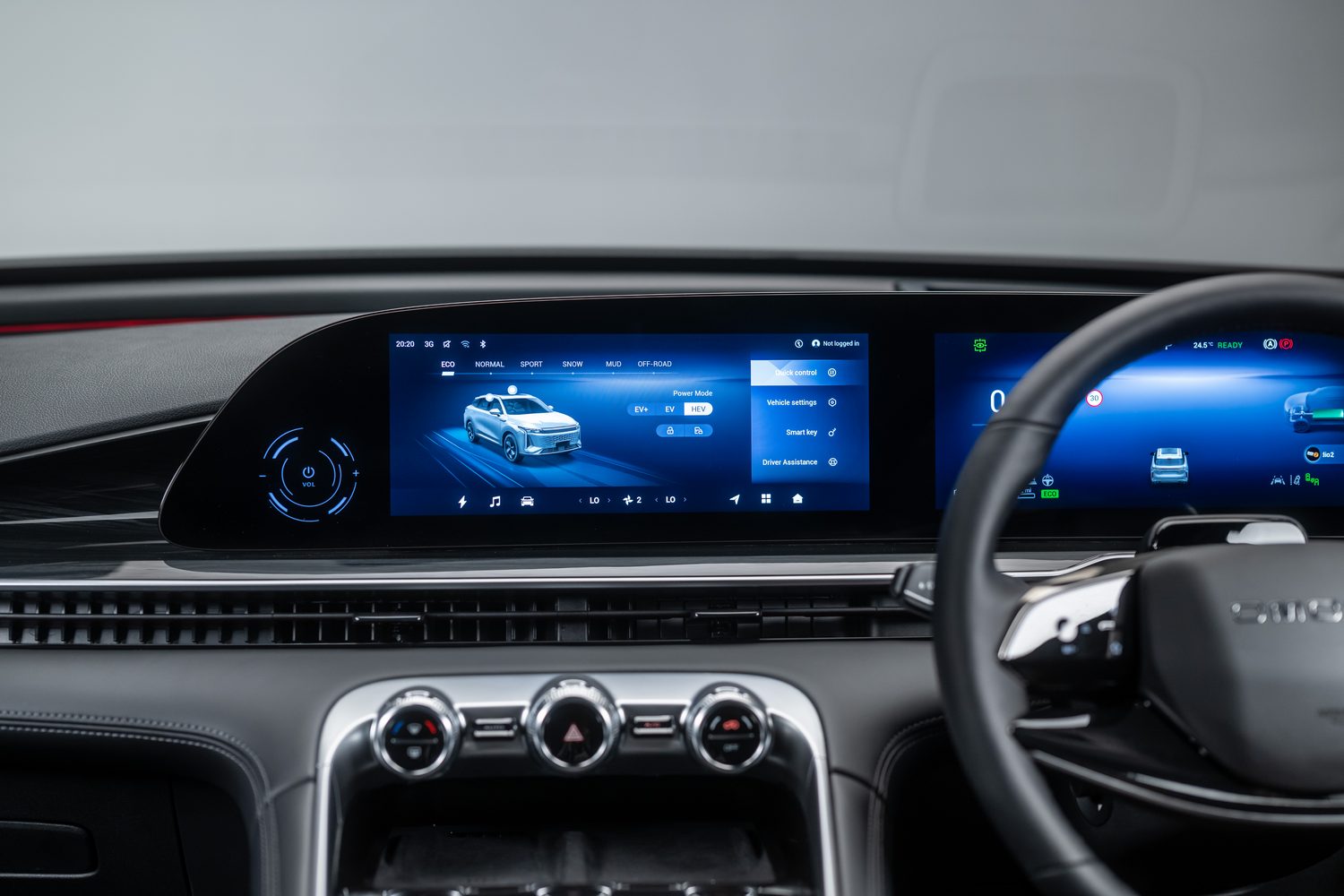
The display can only claim 108.7mpg for the engine because the car is running on electric power for much of the time it's driving, and the situation is reversed for the seemingly record-breaking level of electric efficiency. All of which renders these two read-outs utterly useless, and therefore unnecessary. Rant over.
Back to the positives - space-wise, no gripes from us. Headroom might not be massive in the back of the Omoda 9, especially in the outer two positions which are slightly restricted by the hidden support structures of the 1.3-metre-long panoramic sunroof up top, but the legroom is really generous and the wide body also means three adults should be able to sit side-by-side, even if only for shorter journeys.
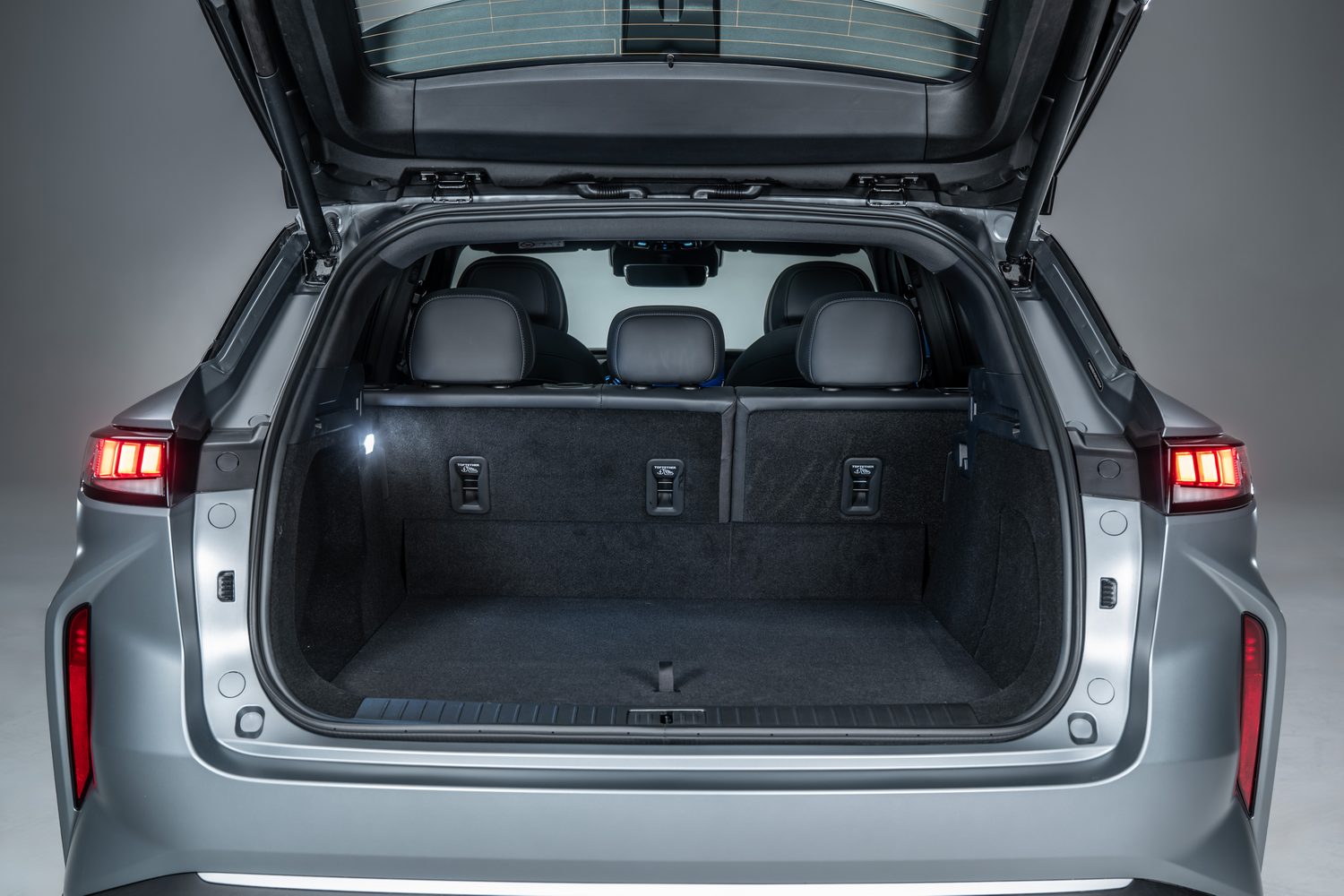
The boot is also an excellent size at 660 litres with all seats in use, rising to 1,783 litres with the 60:40 split-folding rear row dropped away. There is no seven-seat option.
Performance of the 2025 Omoda 9 SHS
• 449hp and 700Nm bestow ample performance on SUV
• Quiet and comfortable to travel in
• No great shakes in the corners
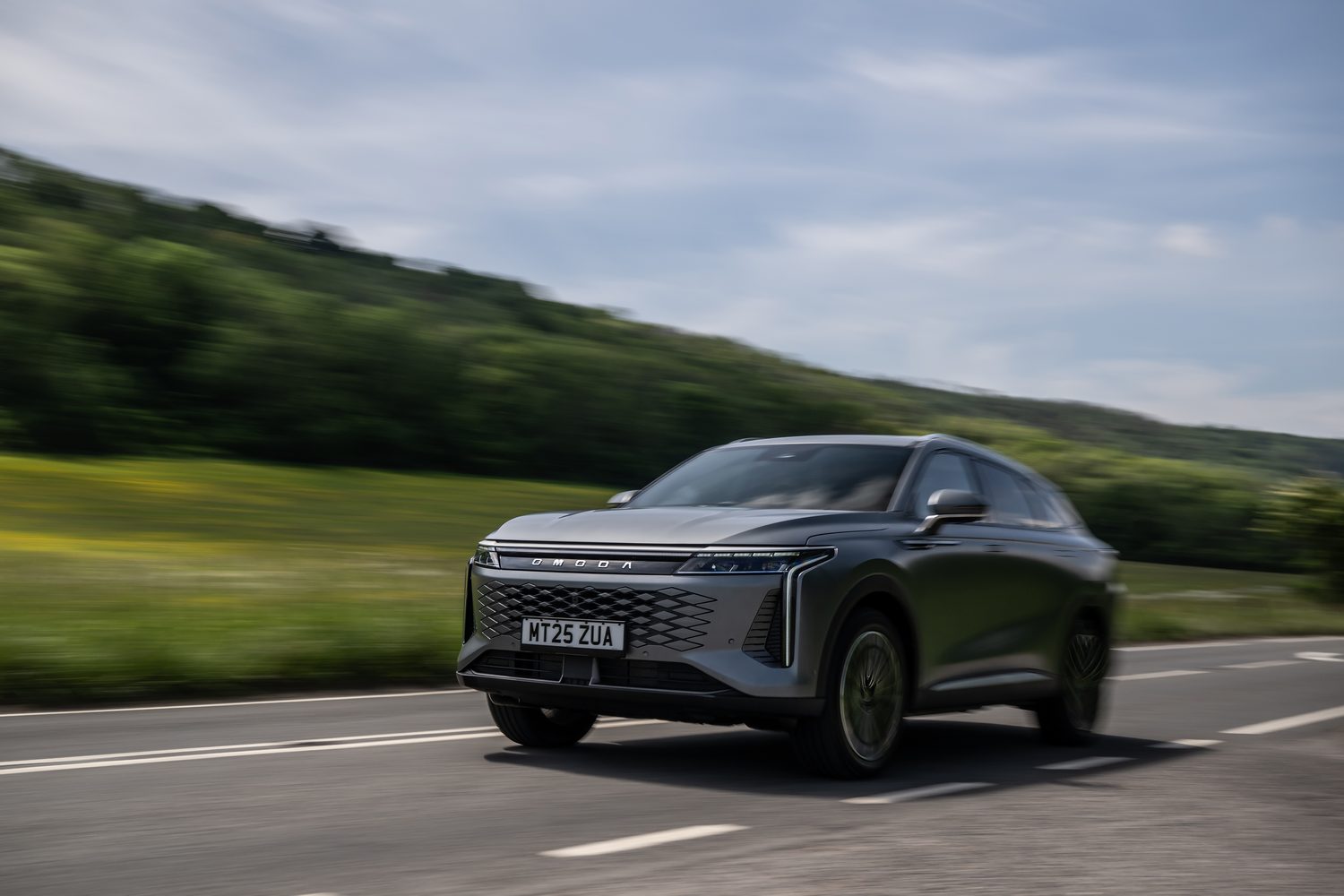
The Omoda uses a complex plug-in hybrid (PHEV) drive system that manages its resources in a wide variety of ways. The system operates as much as it can in a manner which mimics a full electric vehicle, in terms of the smoothness of the power delivery.
To do this, the 9 SHS pairs a turbocharged 1.5-litre four-cylinder petrol engine with something known as the 3DHT (that's 'three-speed dedicated hybrid transmission') gearbox and a couple of electric motors, fuelled by a 70-litre fuel tank and a 34.46kWh battery pack. The peak outputs of this set-up are a decidedly robust 449hp and 700Nm, enough to punch the 2.2-tonne Omoda from 0-100km/h in 4.9 seconds. It also has some serious roll-on acceleration stats, like 30-70km/h in 2.3 seconds and 90-120km/h in 2.8 seconds.
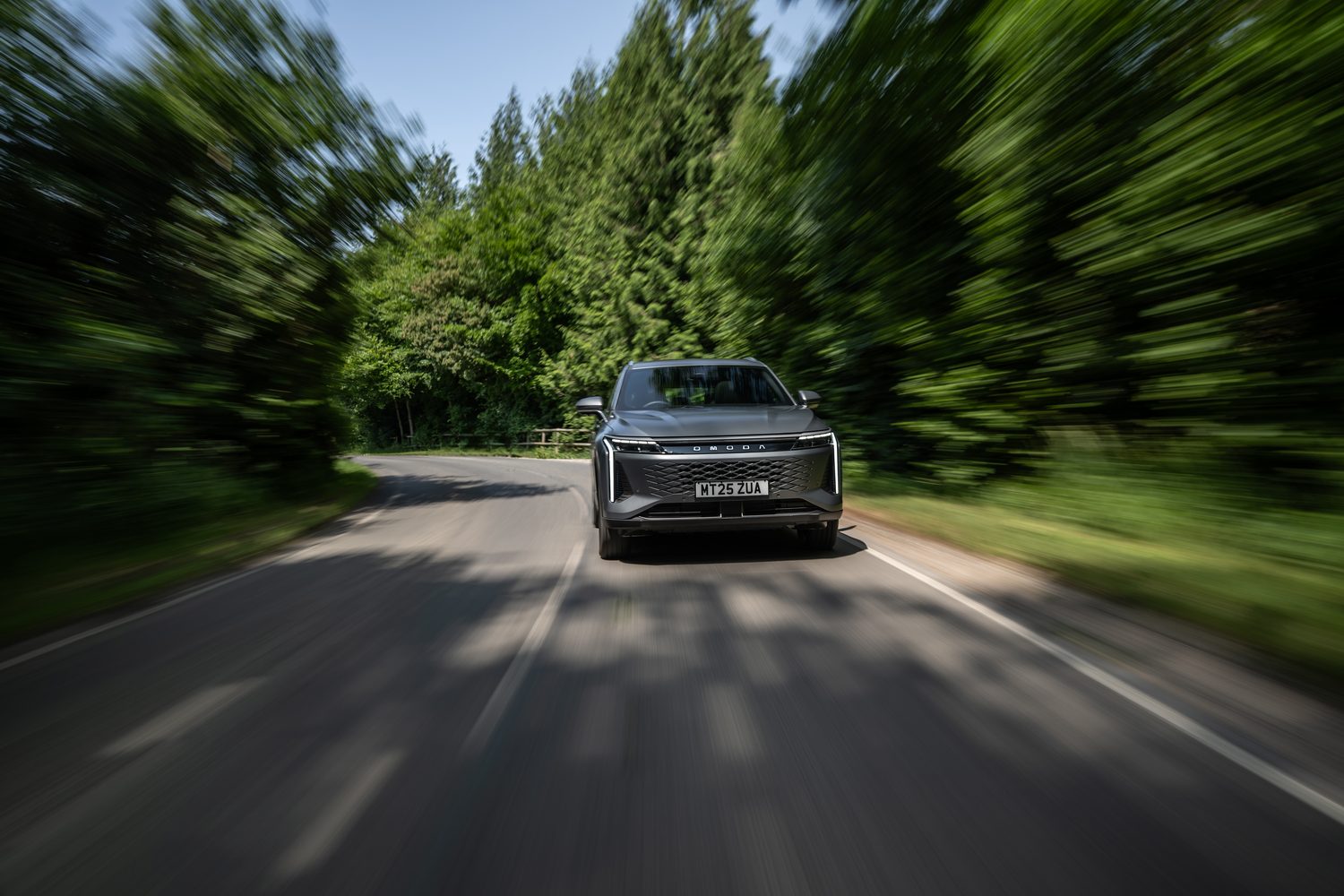
In operation, the 9 SHS's drivetrain works rather well. There's a little bit of hesitance from the throttle as you try and move off from a standstill, but after that the 'gearbox' really is seamless - we didn't once detect a shift from it as we motored around, so it felt very much like a single-speed reduction-gear transmission in a full EV - and there's ample power that's very, very easily accessible. Sure, at slightly higher revs, that 1.5-litre petrol engine isn't the silkiest thing in the world in terms of the noise it makes, but in general it's a properly potent and highly dignified powertrain.
The Omoda 9 rides sweetly too, certainly if the tarmac beneath its wheels is in good condition. It's really only the biggest compressions and perturbations in the road which send a sharp thud through the SUV's structure which betray the ultimate sophistication levels of the damping, but for most of the time you're in it, the SHS is suitably quiet and commendably comfortable.
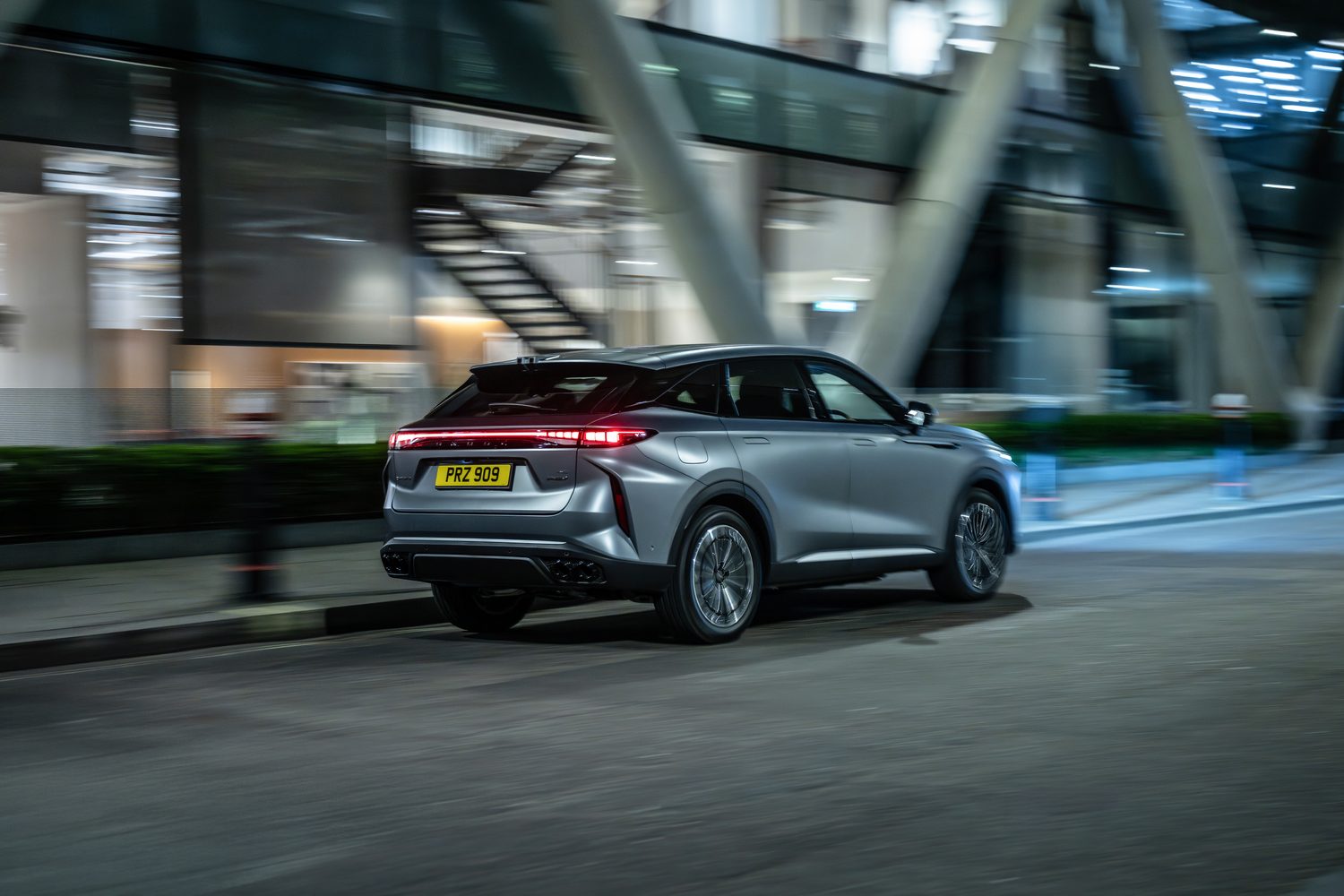
Despite varying modes for the steering, brakes, throttle response and the adaptive electromagnetic dampers in the suspension, we couldn't say we noticed a huge difference in any of these facets when cycling between the three main settings of Eco, Normal and Sport, apart from an extra surge from the powertrain on part-throttle when we switched into the latter.
Having said that, we're not complaining, because the steering is acceptably accurate and well weighted, the suspension provides a good blend of ride comfort and rolling refinement versus body and wheel control (even if the Omoda is never that exciting to hustle through some curves at higher pace), and both the throttle pedal and the level of regenerative braking from the electric motors have both been dialled in competently.
The main issue here is that the brake pedal feel itself is off. First of all, pressing down on the left-hand pedal at low speeds feeds back a wooden sensation, almost as if the brake pedal itself is chocked underneath. So, you apply a little more pressure to try and crack through this odd few centimetres of travel, only for the brakes to bite very suddenly.
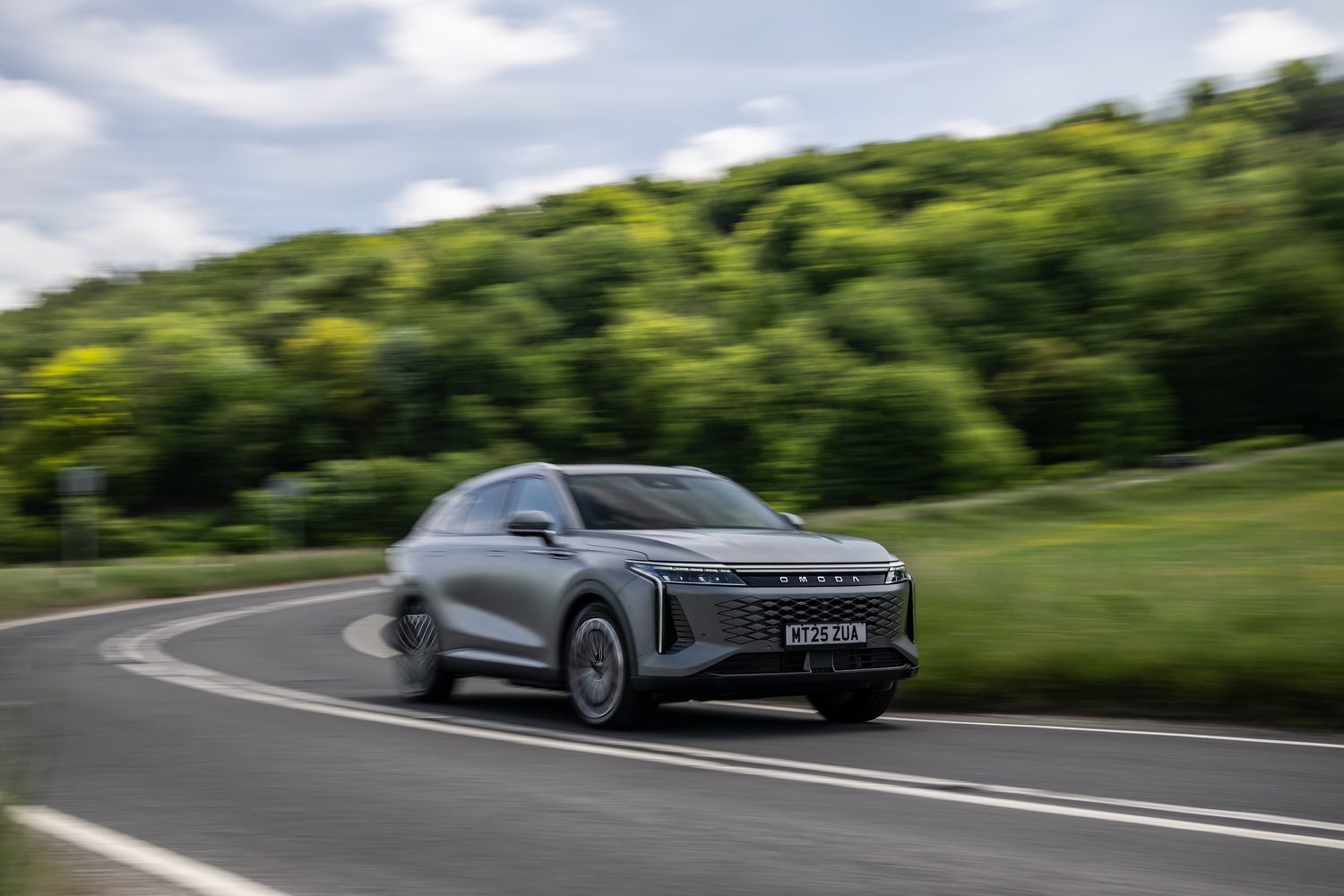
The modulation of the stopping power improves as more speed is dialled on, weirdly enough, and we were also minded by an Omoda representative to note that the test cars had only covered delivery distances, so their brakes probably hadn't fully bedded in. Hence why we'd be keen to try a 9 SHS with a few more kilometres under its belt at some point, just to see if it was the newness of the stoppers that was doing this, or if the friction braking system hasn't been correctly calibrated.
All in all, though, the Omoda 9 feels perfectly composed and accommodating for regular daily driving duties, so with its long range and effortless drivetrain, it's sure to win plenty of fans for its accomplished (if not exceptional) dynamics.
Running Costs of the 2025 Omoda 9 SHS
• Claimed 1,200km range possible
• Up to 150km of all-electric range
• May gain a seven-year warranty

Although Omoda does have full EVs in its ranks in global markets, at the moment there isn't an electric version of the 9 in the pipeline, which leaves this SHS PHEV as the most likely option to come to Ireland. Its low CO2 figure of 38g/km will help put it into the second-lowest motor-tax bracket, while a combined range theoretically in excess of 1,200km from the two disparate halves of its drivetrain looks like a real USP in showrooms.
It achieves this number courtesy of a large 70-litre fuel tank, and an also-large 34.46kWh battery pack, which is on the giant side for a PHEV; in fact, there are some full electric cars running power units that aren't much bigger than that. As a result, Omoda quotes a whopping 150km all-electric range for the 9 SHS, which is one of the best stats of that type for PHEVs worldwide.
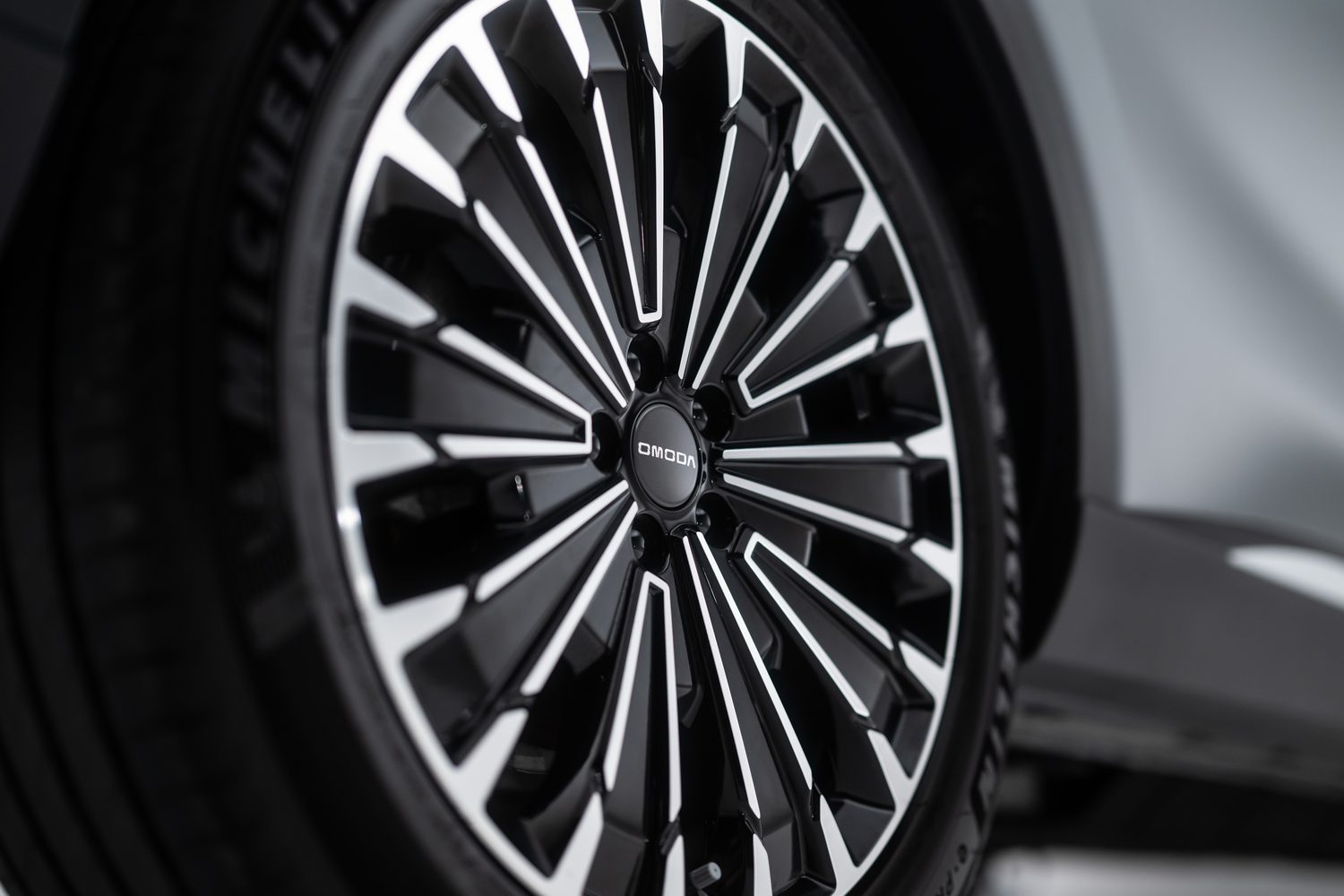
To make sure, though, that owners aren't hanging around charging it for too long, the Omoda 9 SHS can DC charge at up to 70kW, allowing for a 30-80 per cent top-up from a suitable public connection in just 25 minutes.
Omoda quotes an overall WLTP figure of 1.4 litres/100km from the 9 SHS, although it then also says buyers should more likely figure on 7.0 litres/100km with a 'depleted' battery.
That word is in quotation marks because, officially, the energy management system onboard the Omoda and its fancy hybrid system should always ensure there is some charge in the power pack - as in, you shouldn't ever see '0%' showing next to the electric reserve gauge.
This is due to the fact the SHS tries to operate like a normal non-plug-in hybrid at lower battery levels, a bit like the Toyota RAV4 PHEV does, retaining some charge for continued part-electric running, rather than sapping all of it and then forcing the driver to use the combustion engine alone for forward propulsion at the cost of the fuel economy.
Therefore, across an 80km-plus test route, the fact we saw something like 5.9 litres/100km doesn't seem so bad... albeit we weren't ever driving the SUV that quickly for sustained periods and it had more than enough charge (more than 50 per cent) to be able to drive in pure EV mode for longer stretches.
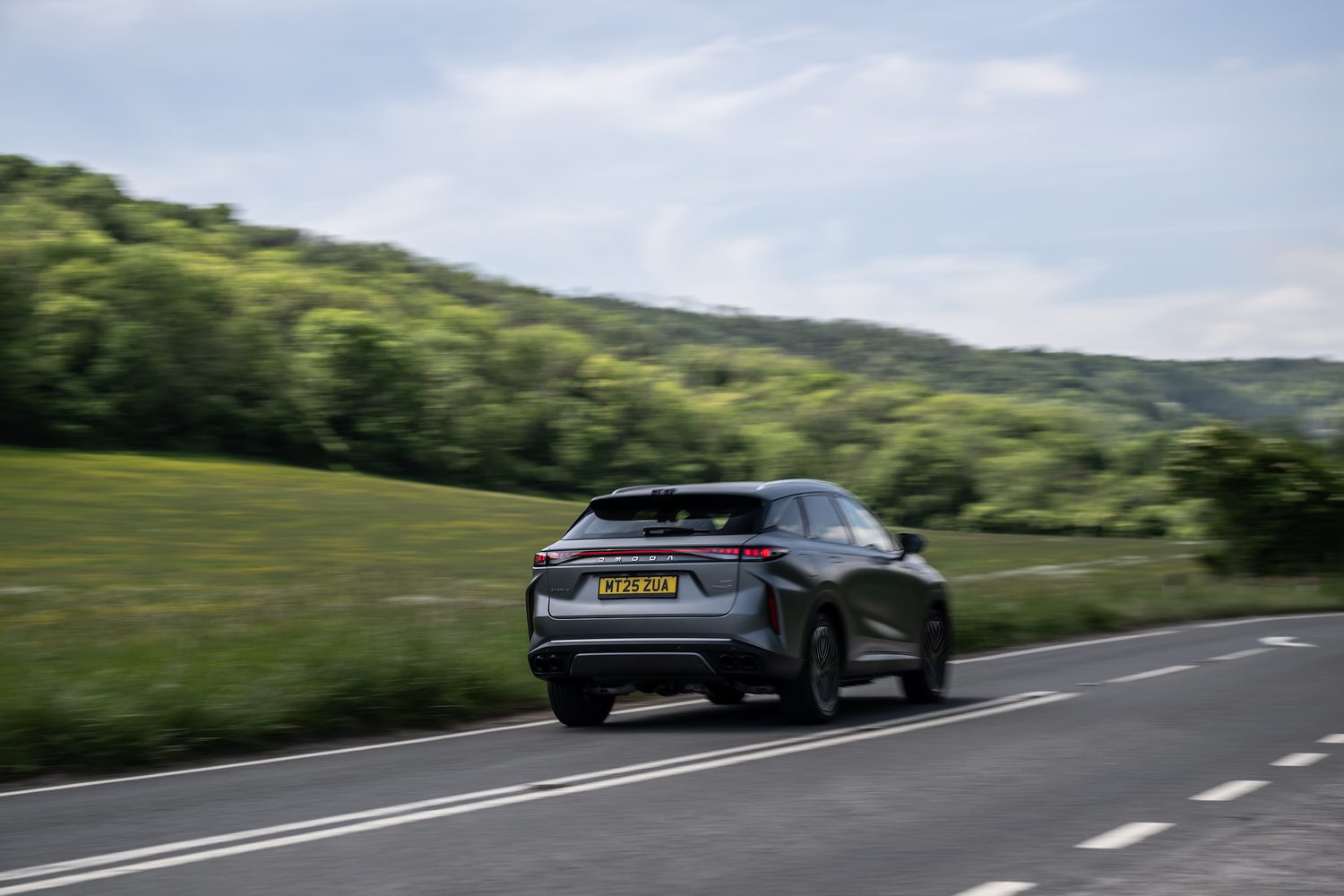
There's no word yet on the Irish level of aftercare, but in the UK all Omodas are covered by a seven-year, 160,000km warranty, with the first three years of that cover valid for unlimited kilometres; it's only years four to seven that the 160,000km cap comes into effect. Hopefully, that same level of back-up and peace of mind will be included here.
Irish Pricing & Rivals of the 2025 Omoda 9 SHS
• No Irish prices confirmed as yet
• Should be in the Qashqai ballpark
• Everything but metallic paint is standard fit
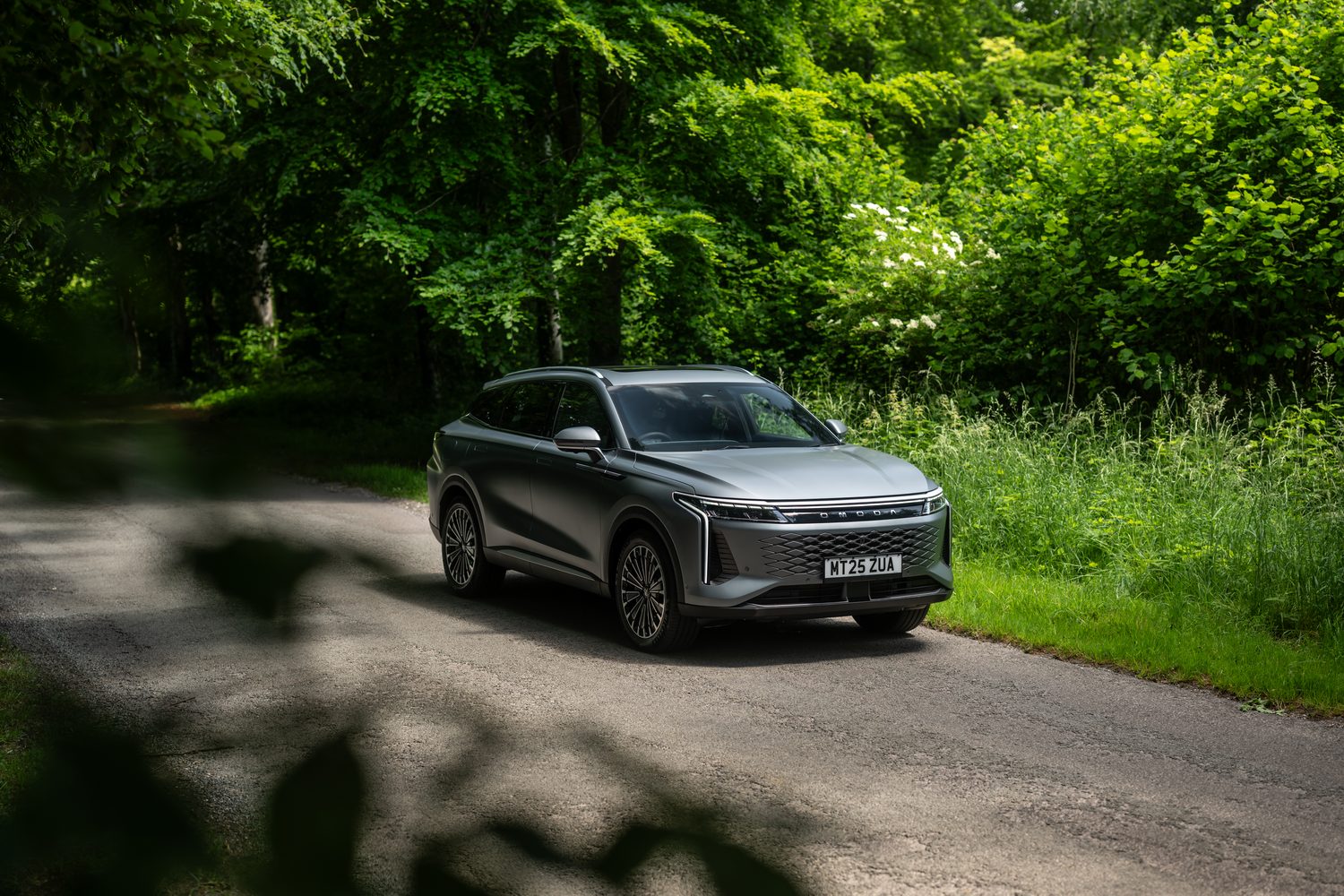
With no prices or Irish specs confirmed as yet, we can't do much but speculate in this section of the review with regards the Omoda 9 SHS. The company says you are 'getting a D-segment SUV for the price of a C-segment one', and by that (D-segment) it means the premium five-seaters - like the BMW X3, Volvo XC60 and Lexus NX, all of which have PHEV options - rather than three-row seven-seaters from more mainstream rivals, such as the Hyundai Santa Fe, Skoda Kodiaq or Kia EV9.
However, you should only be paying the sort of money you would for something like a Volkswagen Tiguan eHybrid, Hyundai Tucson PHEV or Nissan Qashqai E-Power in order to sit in the 9 SHS.
And it comes with absolutely everything as standard, such as the adaptive suspension, radar cruise control, massive opening panoramic sunroof, and heated and ventilated seats in four cabin positions (not just the front chairs), among much, much more. About the only option you can choose for it is a different shade of paint, so if we're talking about the €45,000-€50,000 ballpark for the Omoda, it might well be a conspicuous bargain.
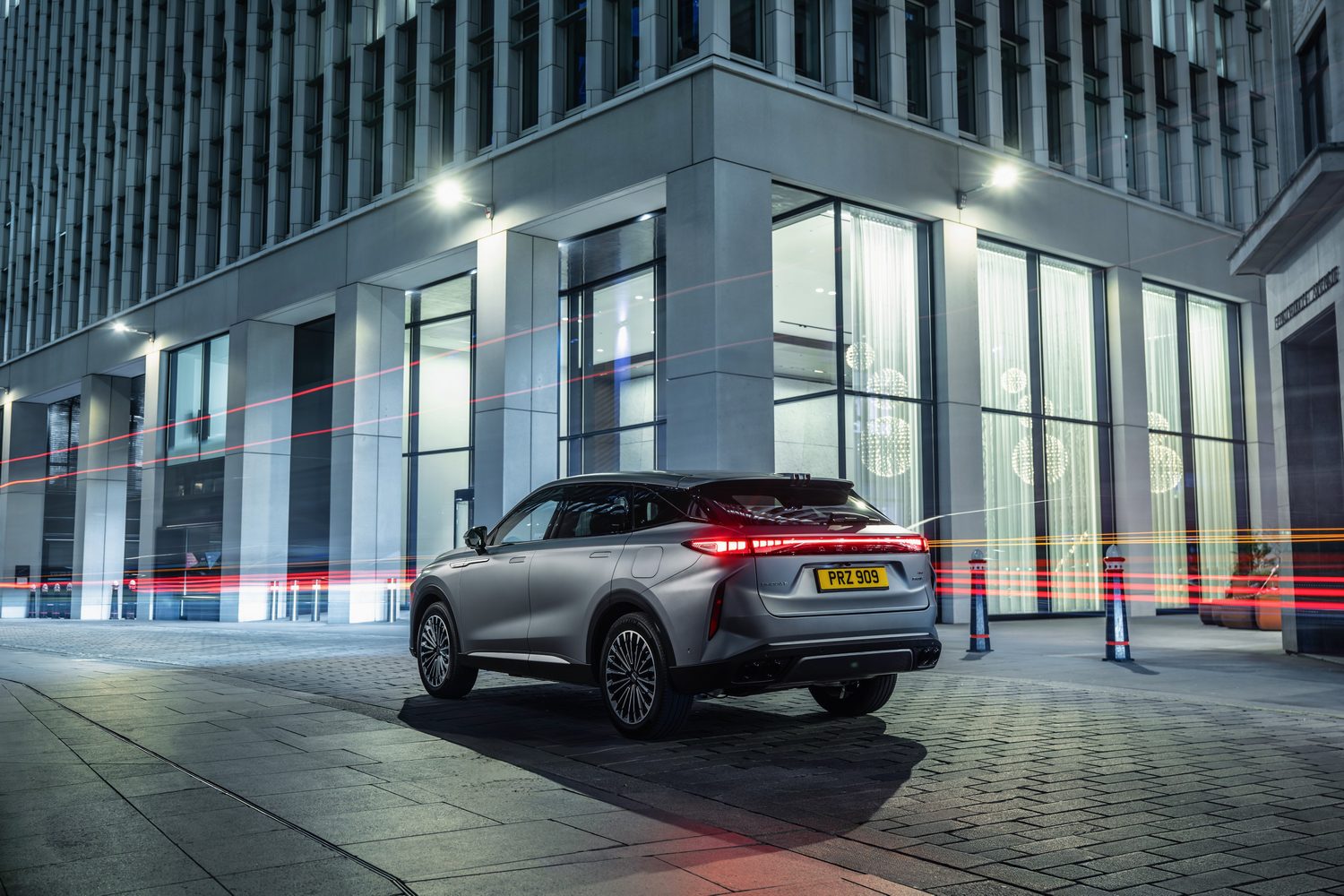
Verdict - Should You Buy the 2025 Omoda 9 SHS?
Something of a rhetorical question for this conclusion this time, given Omoda doesn't have a presence in Ireland yet. So perhaps the poser ought to be: “Should I hang on and wait to see if the Omoda 9 SHS comes here before the year is out?” Well, that timeframe might not be realistic, and the crucial facts connected to any Omoda arrival on our shores will be 'when?' and 'how much?'.
But if the answers to those two questions are favourable, then there's a lot to recommend here. It looks decent inside and out, there's loads of standard equipment, its amenable PHEV drivetrain should give you massive range, and it generally rides and steers in a likeable fashion. There are a few details that could still do with some polishing, but otherwise it's a solid first showing from the Omoda 9 SHS.
FAQs About the 2025 Omoda 9 SHS
How many child seats can I fit in the Omoda 9 SHS?
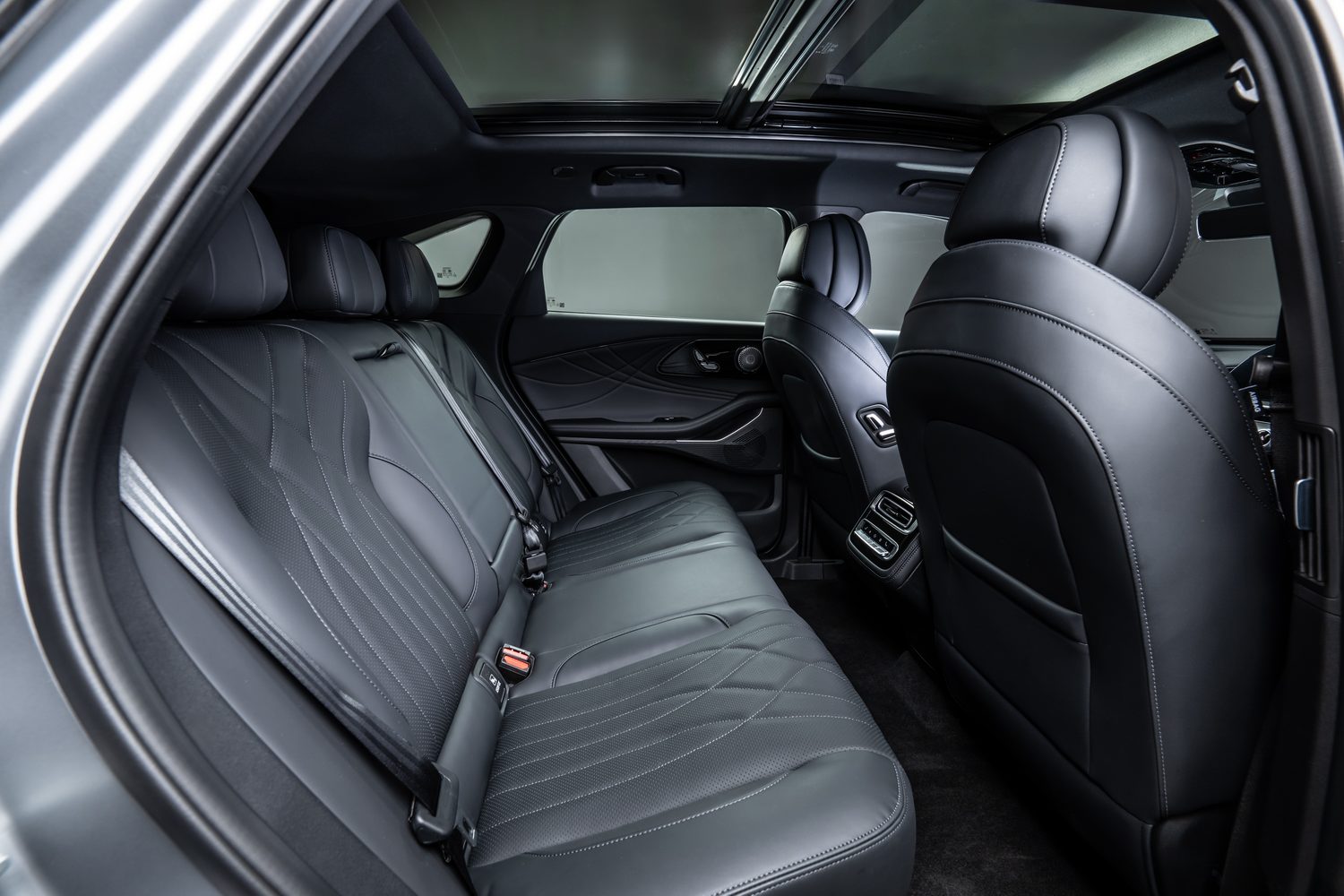
It has two ISOFIX positions on the second row, but there are top mounts on the bench's rear-side for all three seats, curiously enough. The wide body and flat floor in the back suggest that three bulkier chairs might go in there side-by-side, but it'll all depend on how big your child seats are.
Will there be a lesser-powered Omoda 9 SHS?
It's possible, because the related Jaecoo 7 runs a 204hp/310Nm iteration of roughly the same hardware. However, that's a single-motor, front-wheel-drive car with a smaller (18.3kWh) battery pack, so it could well be that only this AWD, 449hp Omoda 9 is offered here as the installation of different battery hardware wouldn't make sense to parent group Chery.
Is the Omoda 9 SHS grander than the equivalent Jaecoo?
The idea is that Omoda is the brand targeted at urban buyers and given a more tech-focused interior, while Jaecoo is the rugged, outdoorsy marque of the Chery family. The bigger Jaecoo 8 would be the analogue of the Omoda 9, but we haven't driven the J8 yet - just the J7.
Want to know more about the Omoda 9 SHS?
Is there anything else you'd like to know about the Omoda 9 SHS? Or anything you feel we haven't covered here? Then just head over to our Ask Us Anything section and, well, ask us anything. We'll do our best to answer your questions.

